Practice Exercises - AP Biology Premium 2024
Practice Questions
Multiple-Choice
1. Which of the following can be used to describe the center of a data set and is NOT affected by extreme values in the data set?
(A) mean
(B) median
(C) standard deviation
(D) standard error of the mean
2. Data Set A consists of {10, 15, 15, 20, 25}. Data Set B consists of {15, 15, 17, 19, 19}. Which of the following descriptive statistics is the same for both data set A and data set B?
(A) mean
(B) median
(C) standard deviation
(D) standard error of the mean
3.The chi-square test is appropriate to compare which of the following types of data?
(A) means
(B) percentages
(C) processed data
(D) raw data
4. In a dihybrid cross of two organisms (AaBb × AaBb), four different phenotypes of offspring can be produced. How many degrees of freedom would there be?
(A) 1
(B) 2
(C) 3
(D) 4
5.In pea plants, the tall (T) allele is dominant to the dwarf (t) allele. Two heterozygous (Tt) pea plants are crossed and produce 400 offspring. Three hundred offspring are expected to be tall, and 100 are expected to be short. There are 290 tall offspring observed and 110 dwarf offspring observed. Calculate the chi-square value from this data (using a p-value of 0.05), and state whether there is likely a statistically significant difference between the observed and expected data.
(A) The chi-square value is 0.67. There is a statistically significant difference between the observed and expected data.
(B) The chi-square value is 0.67. There is NOT a statistically significant difference between the observed and expected data.
(C) The chi-square value is 1.33. There is a statistically significant difference between the observed and expected data.
(D) The chi-square value is 1.33. There is NOT a statistically significant difference between the observed and expected data.
6. A student wanted to see if isopods preferred banana or watermelon as a food source. Twenty isopods were placed in the center of a choice chamber with two compartments. Banana was placed in one compartment, and watermelon was placed in the second compartment. After 15 minutes, the number of isopods in each compartment was counted. Data are shown in the table.

The null hypothesis was that the isopods would have no food preference and would be found in equal numbers in both compartments. Calculate the chi-square value (using a p-value of 0.05), and determine if there was a statistically significant difference between the observed and expected data in this experiment.
(A) The chi-square value is 0.80. There is a statistically significant difference between the observed and expected data.
(B) The chi-square value is 0.80. There is NOT a statistically significant difference between the observed and expected data.
(C) The chi-square value is 3.20. There is a statistically significant difference between the observed and expected data.
(D) The chi-square value is 3.20. There is NOT a statistically significant difference between the observed and expected data.
7. Data Set X and Data Set Y have the same standard deviations. Data Set X has a sample size of 10, while Data Set Y has a sample size of 50. How will their standard errors of the mean compare?
(A) Data Set X will have a larger standard error of the mean than Data Set Y.
(B) Data Set Y will have a larger standard error of the mean than Data Set X.
(C) Both data sets will have the same standard error of the mean.
(D) The difference in the standard errors of the mean cannot be determined from the information given.
Questions 8 and 9
The heights of oak trees in four different locations were measured. The mean height and the standard error of the means were calculated for each location and are shown in the table.
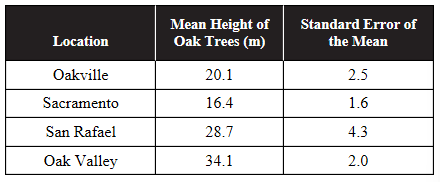
8. Which location showed the greatest variability in the heights of the oak trees?
(A) Oakville
(B) Sacramento
(C) San Rafael
(D) Oak Valley
9. Which of the following two locations are likely to have a statistically significant difference between the heights of their oak trees?
(A) Oakville and Sacramento
(B) Oakville and Oak Valley
(C) San Rafael and Oak Valley
(D) San Rafael and Oakville
(A) Mean ± 1(Standard Deviation)
(B) Mean ± 1(Standard Error of the Mean)
(C) Mean ± 2(Standard Deviation)
(D) Mean ± 2(Standard Error of the Mean)
Short Free-Response
11. Some chemicals are known to increase the frequency of chromosome breakage in dividing cells. Thirty Petri dishes with dividing cells were treated with either lead (10 Petri dishes), cadmium (10 Petri dishes), or control solutions (10 Petri dishes). Forty-eight hours after treatment, each Petri dish was examined, and the percentage of cells that showed chromosome breakage in each Petri dish was calculated. The mean percentage of cells that showed chromosome breakage and the standard error of the mean for each treatment were calculated and are shown in the table.
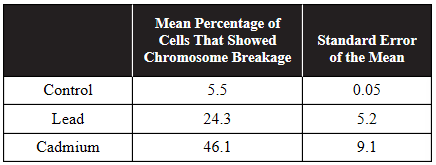
(a) Describe which treatment produced the greatest variability in the data.
(b) Describe which treatment was least likely to result in chromosome breakage.
(c) A student claims that exposure to cadmium is more likely to result in chromosome breakage than exposure to lead. Evaluate this claim using the data provided.
(d) Identify the independent variable and the dependent variable in this experiment.
12. In tobacco plants, green (G) is dominant to albino (g). A heterozygous green (Gg) tobacco plant is crossed with an albino (gg) tobacco plant, and 100 offspring are produced. Fifty offspring are expected to be green (Gg), and 50 offspring are expected to be albino (gg). However, when the offspring are counted, 60 green plants and 40 albino plants are observed.
(a) Identify the degrees of freedom in this experiment.
(b) Calculate the chi-square value for this data.
(c) Make a claim about whether or not the observed data are likely significantly different statistically from the expected data. Use a p-value of 0.05.
(d) Justify your claim from part (c) with your knowledge of the chi-square test.
Long Free-Response
13. Organic gardeners will sometimes use ladybugs as a method of reducing aphid populations in their gardens. A garden infested with aphids is divided into three sections. In the first section, no treatment (to reduce the aphid populations) is applied. In the second section, ladybugs are introduced to reduce the aphid populations. In the third section, a chemical pesticide is used to reduce the aphid populations. One week after the treatments are applied, 10 measurements of the density of the aphid populations (in aphids per square decimeter) are taken in each section of the garden. The means and the 95% confidence intervals for each section of the garden are shown in the graph.
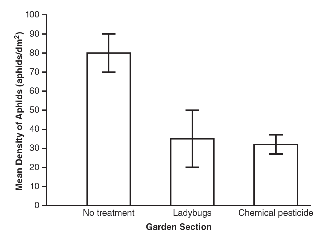
(a) Based on the graph, identify the section of the garden with the least variability in aphid density and the section of the garden with the most variability in aphid density one week after treatment.
(b) Analyze the data shown in the graph to determine which sections of the garden are most likely to have a statistically significant difference in aphid density.
(c) In this experiment, 10 measurements (n = 10) of the aphid density were taken in each section of the garden. If 50 measurements (n = 50) were taken, make a prediction about the effect, if any, this would have on the 95% confidence intervals.
(d) Justify your prediction from part (c) using your knowledge of how 95% confidence intervals are calculated.
Practice Questions
Multiple-Choice
1. In a water molecule, hydrogen atoms are attached to oxygen atoms through which type of bond?
(A) hydrogen bond
(B) nonpolar covalent bond
(C) polar covalent bond
(D) ionic bond
2. The attraction between the partially positive charge on a hydrogen atom on one water molecule and the partially negative charge on an oxygen atom on another water molecule is called a(n)
(A) hydrogen bond.
(B) nonpolar covalent bond.
(C) polar covalent bond.
(D) ionic bond.
3. Water’s high specific heat is due to
(A) the lower density of solid ice compared to that of liquid water.
(B) the amount of energy required to break the covalent bonds within a water molecule.
(C) the amount of energy required to break the hydrogen bonds between water molecules.
(D) the low electronegativity of oxygen atoms compared to that of hydrogen atoms.
4. Which of the following solutions has the greatest concentration of H+?
(A) stomach acid with a pH of 2
(B) acetic acid with a pH of 3
(C) coffee with a pH of 5
(D) bleach with a pH of 12
5. Solution A has a pH of 4; solution B has a pH of 7. How do the [H+] in these solutions compare?
(A) Solution A has 3 times the [H+] concentration of solution B.
(B) Solution A has 30 times the [H+] concentration of solution B.
(C) Solution A has 1,000 times the [H+] concentration of solution B.
(D) Solution A has 3,000 times the [H+] concentration of solution B.
6. Coastal areas near large bodies of water tend to have more stable climates than inland areas at the same latitude. Which of the following is the property of water that best explains this difference in climate?
(A) high surface tension
(B) high specific heat
(C) capillary action
(D) density of ice
7. Small, lightweight insects can walk on the surface of water, as seen in the following figure:
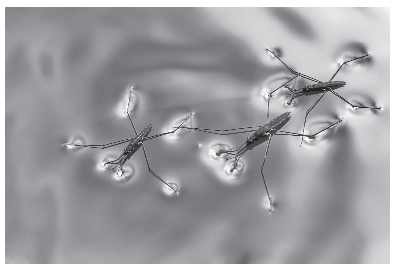
Which of the following is the property of water that best explains this phenomenon?
(A) high surface tension
(B) high specific heat
(C) capillary action
(D) density of ice
8. Arctic seals and walruses rely on ice floes for survival. Which of the following best explains why these ice floes exist?
(A) high surface tension
(B) high specific heat
(C) capillary action
(D) density of ice
9. Redwood trees, which are over 200 feet tall, can move water upward from their roots to other parts of the tree, despite the downward pull of gravity. Which of the following properties of water best explains this?
(A) high surface tension
(B) high specific heat
(C) capillary action
(D) density of ice
10. In hot weather, humans can cool their body temperature by sweating. Which of the following properties of water makes this possible?
(A) high surface tension
(B) high specific heat
(C) capillary action
(D) density of ice
Short Free-Response
11. On hot summer days, misters will sometimes be used to cool participants at outdoor events.
(a) Describe the property of water that allows misters to have an effective cooling effect.
(b) Explain why the evaporation of water makes the participants in these events more comfortable.
(c) Instead of water, nonpolar oil is spread on the skin. Predict whether this would have a less effective cooling effect, a more effective cooling effect, or the exact same cooling effect as water on the skin.
(d) Using what you know about the comparative properties of water and nonpolar substances, justify your prediction from part (c).
12. Refer to the following figure, which depicts water and methane.
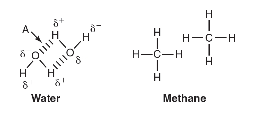
(a) Describe the type of bond indicated by arrow A.
(b) Explain why the bond indicated by arrow A forms between water molecules.
(c) Would an ionic salt dissolve more readily in water or methane? Explain your reasoning.
(d) Plants in arid climates often need to conserve water loss due to evaporation through the leaves of the plant. Some plant species have a waxy, nonpolar cuticle on the outer surface of their leaves. A student claims that this waxy cuticle reduces water loss from the leaves. Support the student’s claim with reasoning.
Long Free-Response
13. Aquatic animals produce carbon dioxide as a product of cellular respiration. Carbon dioxide combines with water to form carbonic acid (H2CO3), which releases hydrogen ions (H+) into solution. Four test tubes (containing 10 mL of water each and different numbers of aquatic snails) are prepared. pH levels were measured in each tube at the beginning of the experiment and after 20 minutes. The results are shown in the following table.
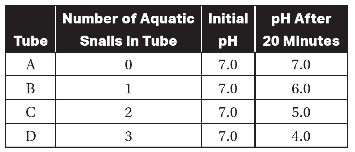
(a) Explain why tubes B, C, and D all had lower pH levels after 20 minutes.
(b) Identify the independent variable and the dependent variable in this experiment.
(c) Analyze the data, and predict which tube (B, C, or D) contained 100 times as many H+ ions as that of tube A after 20 minutes.
(d) Aquatic plants, such as Elodea, perform cellular respiration, but they also perform photosynthesis. Photosynthesis removes carbon dioxide from the water, reducing the amount of carbonic acid. Predict the effect of adding Elodea to all four tubes at the start of the experiment. Justify your prediction.
Practice Questions
Multiple-Choice
1. COVID-19 is a single-stranded RNA virus. Which molecules would most likely be found in a single-stranded RNA virus, such as COVID-19?
(A) adenine, cytosine, deoxyribose, guanine, thymine
(B) adenine, cytosine, deoxyribose, guanine, uracil
(C) adenine, cytosine, ribose, guanine, thymine
(D) adenine, cytosine, ribose, guanine, uracil
2. A scientist conducted an experiment to find out what type of macromolecule a virus injects into a cell. Using radiolabeled atoms, the scientist found that phosphorus from the virus entered the cell but sulfur did not. Which of the following molecules would most likely be injected from this virus into the cell?
(A) carbohydrate
(B) nucleic acid
(C) protein
(D) steroid
3. Which of the following best describes the formation of the primary structure of a protein?
(A) A dehydration reaction forms an ionic bond between the carboxyl group of one amino acid and the amino group of another amino acid.
(B) A dehydration reaction forms a covalent bond between the carboxyl group of one amino acid and the amino group of another amino acid.
(C) A hydrolysis reaction forms an ionic bond between the carboxyl group of one amino acid and the amino group of another amino acid.
(D) A hydrolysis reaction forms a covalent bond between the carboxyl group of one amino acid and the amino group of another amino acid.
4. Which of the following best describes the differences between saturated and unsaturated lipids?
(A) Saturated lipids have at least one C=C double bond and tend to be solid at room temperature. Unsaturated lipids have no double bonds and tend to be liquid at room temperature.
(B) Saturated lipids have at least one C=C double bond, which makes them amphipathic. Unsaturated lipids have no double bonds and are hydrophilic.
(C) Saturated lipids have no C=C double bonds and tend to be solid at room temperature. Unsaturated lipids have at least one C=C double bond and tend to be liquid at room temperature.
(D) Saturated and unsaturated lipids both have C=C double bonds. Saturated lipids are hydrophobic, and unsaturated lipids are hydrophilic.
5. The molecular formula for glucose is C6H12O6. The molecule maltose is formed by a dehydration reaction that links two glucose molecules together. What is the molecular formula for maltose?
(A) C2H4O2
(B) C6H10O5
(C) C12H22O11
(D) C12H24O12
6. In an aqueous environment like the cytosol, the most stable tertiary protein structures would have hydrophilic amino acids in which part of the protein’s structure?
(A) in the interior of the protein, interacting with water in the cytosol
(B) in the interior of the protein, avoiding water in the cytosol
(C) on the surface of the protein, interacting with water in the cytosol
(D) on the surface of the protein, avoiding water in the cytosol
7. Which level of protein structure is formed by peptide bonds between amino acids?
(A) primary
(B) secondary
(C) tertiary
(D) quaternary
8. Which of the following drives the formation of a protein’s secondary structure?
(A) Hydrophobic interactions form between R-groups of amino acids.
(B) Hydrogen bonds form between amino acids in a polypeptide chain.
(C) Disulfide bridges form between amino acids in a polypeptide chain.
(D) Multiple subunits/domains of a protein are connected by covalent bonds.
9. Which of the following is common to both DNA and RNA?
(A) the nitrogenous bases: adenine, cytosine, guanine, and thymine
(B) a double-stranded antiparallel helix
(C) a phosphate group attached to the 5′ carbon
(D) the five-carbon sugar ribose
10. Which of the following correctly describes DNA but not RNA?
(A) It contains adenine, cytosine, guanine, and uracil.
(B) A hydroxyl group is attached to the 5′ carbon.
(C) Nucleotides are linked by phosphodiester bonds.
(D) It contains the five-carbon sugar deoxyribose.
Short Free-Response
11. A student conducts an experiment to compare the melting points of an unsaturated fatty acid and a saturated fatty acid. The data are shown in the table.
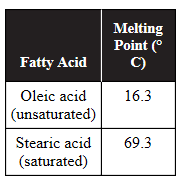
(a) Describe the structural differences between an unsaturated fatty acid and a saturated fatty acid.
(b) Identify the independent variable and the dependent variable in this experiment.
(c) The membrane surrounding cell A contains a much higher percentage of unsaturated fatty acids than the membrane surrounding cell B. Predict which cell would have a more flexible membrane.
(d) Justify your prediction from part (c).
12. The melting temperature (Tm) is defined as the temperature at which 50% of double-stranded DNA is separated into single-stranded DNA. The greater the guanine-cytosine (poly-GC) of the DNA, the higher the Tm compared to DNA with more adenine-thymine (poly-AT) content. The following graph shows the Tm of a poly-AT DNA strand, a poly-GC DNA strand, and DNA from two different organisms (A and B).
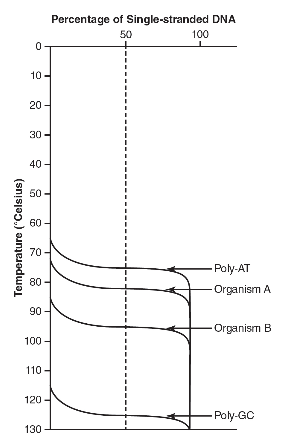
(a) Describe how the Tm of DNA from organism A compares to the Tm of DNA from organism B.
(b) Describe the differences between the Tm of poly-AT and the Tm of poly-GC DNA.
(c) DNA sequencing finds that DNA from organism A has a GC content of 39% and that DNA from organism B has a GC content of 48%. A student claims that DNA from organism C (with a GC content of 55%) would have a Tm greater than 85° Celsius. Using the data from the figure, evaluate the student’s claim.
(d) Explain how these experimental results relate to the structure of DNA.
Long Free-Response
13. Genomes with a higher GC content are more likely to resist denaturation. A plant biologist hypothesized that plants with a higher GC content in their genomes are more likely to be found in colder climates. Four species of plants were examined for the percentage of GC content in their genomes. Brachypodium pinnatum and Dioscorea caucasica are native to areas with cold winters. Juncus inflexus and Carex acutiformis are native to areas with warmer winters. DNA was examined from 50 plants of each species. Results are shown in the table.
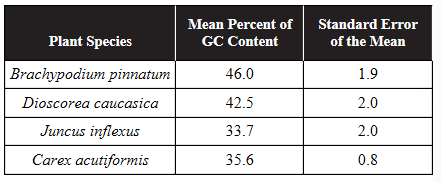
(a) Using what you know about DNA structure, explain why genomes with a higher GC content might be more stable than genomes with a lower GC content.
(b) On the axes provided, construct an appropriately labeled graph of the mean percent of GC content in each species’s genome. Include 95% confidence intervals.

(c) Do the data support the claim that plants in colder climates have a higher GC content in their genomes? Use the data provided to support your answer.
(d) A plant species has a genome with a GC content of 43.4%. Predict whether that plant is more likely to be native to an area with cold winters or an area with warmer winters. Justify your prediction.
Practice Questions
Multiple-Choice
1. An animal cell that lacks glycolipids and glycoproteins in its plasma membrane would likely be unable to carry out which of the following functions?
(A) cell recognition
(B) maintaining the fluidity of the phospholipid bilayer
(C) endocytosis
(D) creating a membrane potential
2. When some bacteria are exposed to antibiotics, the bacteria use ATP to try to pump the antibiotics out of their cells. Which of the following processes is most likely used to do this?
(A) osmosis
(B) diffusion
(C) active transport
(D) endocytosis
3. Which of the following is NOT a component of the cell membrane?
(A) phospholipids
(B) cellulose
(C) proteins
(D) glycolipids
4. Muscle cells require large amounts of energy to function. Which cellular organelle is most likely found in high concentrations in muscle cells?
(A) lysosome
(B) Golgi complex
(C) amyloplast
(D) mitochondria
5. Niemann-Pick disease is caused by the cell’s inability to break down large lipid molecules. Which cellular organelle is most likely not functioning properly in an individual with Niemann-Pick disease?
(A) rough endoplasmic reticulum
(B) Golgi complex
(C) lysosomes
(D) ribosomes
6. A student has access to four dyes that stain different components of cells, as shown in the following table.
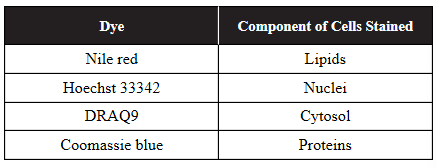
Which dye would be the best choice to use to distinguish prokaryotic cells from eukaryotic cells?
(A) Nile red
(B) Hoechst 33342
(C) DRAQ9
(D) Coomassie blue
7. Which types of molecules pass through the cell membrane unassisted most easily?
(A) small and hydrophilic
(B) small and hydrophobic
(C) large and hydrophilic
(D) large and hydrophobic
8. A cell is not able to modify and package proteins for secretion from the cell. Which of the following organelles is most likely not functioning correctly?
(A) ribosomes
(B) lysosomes
(C) vacuoles
(D) Golgi complex
9. Which of the following is NOT evidence that supports the endosymbiosis hypothesis?
(A) Mitochondria and chloroplasts have their own circular DNA.
(B) Mitochondria and chloroplasts have their own ribosomes.
(C) Mitochondria and chloroplasts reproduce by binary fission.
(D) Mitochondria and chloroplasts are found in all eukaryotic cells.
10. A molecule is moving from an area of higher concentration outside of a cell to an area of lower concentration inside the cell. Which process best describes the movement of this molecule?
(A) active transport
(B) diffusion
(C) endocytosis
(D) exocytosis
Short Free-Response
11. A student conducts an experiment to investigate which cell shape would allow for the most efficient exchange of materials with its environment. Agar blocks (containing bromothymol blue dye) are cut into three different shapes to model three differently shaped cells. The agar blocks are then placed in a vinegar solution. As the vinegar diffuses into the agar models, the acid in the vinegar will turn the bromothymol blue dye yellow. The time required for each agar model to turn completely yellow is measured and is an indication of the efficiency of movement of materials into the agar models. The shape, volume, and surface area of each agar block is shown in the table.
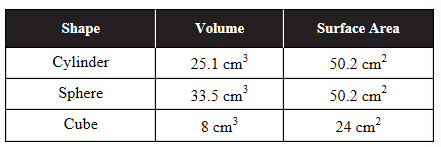
(a) Describe the measurement that would best predict the efficiency of each agar block’s exchange of materials with its environment. Calculate that measurement for each agar block.
(b) Identify the independent variable and the dependent variable in this experiment.
(c) Predict which cell would turn completely yellow first.
(d) Justify your prediction from part (c).
12. Apoptosis is programmed cell death. Apoptosis is often triggered by mutations that could cause a cell to form a tumor if the cell continued to grow and multiply.
(a) Describe the organelle in a eukaryotic cell that is most likely to participate in apoptosis.
(b) Explain other functions the organelle from part (a) would have in the cell besides participating in apoptosis.
(c) A mutation causes the enzymes in the organelle from part (a) to become nonfunctional. Predict what effects this would have on the cell.
(d) Justify your prediction from part (c).
Long Free-Response
13. Two different molecules, A and B, can enter a cell using passive transport. A cell that did not initially contain molecule A or molecule B was placed in a beaker with a solution containing equal concentrations of both molecules for 30 minutes. The cell was removed from the beaker, and the concentration of each molecule inside the cell was measured. The experiment was repeated with different, but equal, starting concentrations of molecules A and B in the beaker. The data are shown in the table.
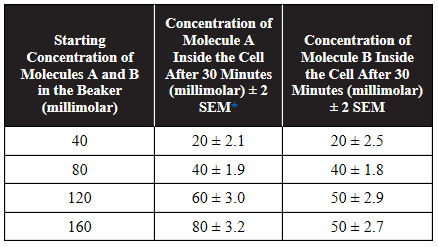
*Standard Error of the Mean
(a) Describe two types of passive transport.
(b) Using the axes provided, construct a graph of this data. Include 95% confidence intervals.

(c) Based on the data, make a claim about which molecule (A or B) uses simple diffusion and which molecule uses facilitated diffusion. Justify your claim with evidence from the data.
(d) This experiment is repeated with the addition of a molecule that irreversibly binds to transport proteins in the cell membrane. Make a prediction about what, if any, changes this would lead to in the data. Justify your prediction.
Practice Questions
Multiple-Choice
1. The solute potential of distilled water is
(A) negative.
(B) zero.
(C) positive.
(D) dependent on the temperature.
2. A solution has a solute concentration of 0.25 moles per liter and is at a temperature of 37°C. The ionization constant of the solute is 1. What is the solute potential of this solution?
(A) –0.64 bars
(B) –0.77 bars
(C) –6.44 bars
(D) –7.70 bars
3. A cell has a solute potential of –5.42 bars and a pressure potential of 0.48 bars. What is its total water potential?
(A) –5.42 bars
(B) –4.94 bars
(C) 0.48 bars
(D) 4.94 bars
4. A blood cell with a water potential of –7.7 bars is placed in distilled water. Which of the following correctly describes what will occur?
(A) Water will flow out of the blood cell because the blood cell has a higher water potential than distilled water.
(B) Water will flow into the blood cell because the blood cell has a higher water potential than distilled water.
(C) Water will flow out of the blood cell because the blood cell has a lower water potential than distilled water.
(D) Water will flow into the blood cell because the blood cell has a lower water potential than distilled water.
5. A plant cell with a solute potential of –4.0 bars and a pressure potential of 0.5 bars is placed into a solution with a water potential of –5.0 bars. What will happen to the plant cell in this solution?
(A) Water will flow into the plant cell because the plant cell has a total water potential that is lower than that of the surrounding solution.
(B) Water will flow into the plant cell because the plant cell has a total water potential that is higher than that of the surrounding solution.
(C) Water will flow out of the plant cell because the plant cell has a total water potential that is lower than that of the surrounding solution.
(D) Water will flow out of the plant cell because the plant cell has a total water potential that is higher than that of the surrounding solution.
6. Four solutions of covalent compounds are in beakers that are open to the atmosphere. Which of the following solutions has the highest water potential?
(A) 0.5 molar glucose at a temperature of 21°C
(B) 0.75 molar fructose at a temperature of 21°C
(C) 1.0 molar sucrose at a temperature of 21°C
(D) 1.25 molar lactose at a temperature of 21°C
7. A freshwater fish is placed in a saltwater aquarium. Predict the most likely effect this will have on the fish, and justify your prediction.
(A) The fish will gain water because it likely has a lower water potential than its new surroundings.
(B) The fish will lose water because it likely has a lower water potential than its new surroundings.
(C) The fish will gain water because it likely has a higher water potential than its new surroundings.
(D) The fish will lose water because it likely has a higher water potential than its new surroundings.
8. Potato slices that are immersed in distilled water for 24 hours become stiff and hard. Potato slices that are immersed in 0.5 molar sucrose solution for 24 hours become limp and soft. Which of the following is the most logical conclusion based on this information?
(A) The potato slices are hypotonic to both distilled water and the 0.5 molar sucrose solution.
(B) The potato slices are hypertonic to both distilled water and the 0.5 molar sucrose solution.
(C) The potato slices are hypotonic to distilled water and hypertonic to the 0.5 molar sucrose solution.
(D) The potato slices are hypertonic to distilled water and hypotonic to the 0.5 molar sucrose solution.
9. Human cells have an approximate NaCl concentration of 0.15 moles per liter. Seawater has an approximate NaCl concentration of 0.45 moles per liter. Which of the following is the most likely effect if a person drank seawater?
(A) The lower water potential in the human cells would cause water to flow out of the human cells into the seawater that was consumed.
(B) The lower water potential in the human cells would cause NaCl to flow out of the human cells into the seawater that was consumed.
(C) The higher water potential in the human cells would cause water to flow out of the human cells into the seawater that was consumed.
(D) The higher water potential in the human cells would cause NaCl to flow out of the human cells into the seawater that was consumed.
10. A dandelion plant is growing in an environment with a temperature of 21°C. The water potential in the root cells of a dandelion plant is –1.2 bars. If a 0.1 molar sodium chloride solution at 21°C was poured on the dandelion roots, what would be the most likely result?
(A) Sodium chloride would move into the dandelion cells, raising the water potential of the dandelion cells.
(B) Water would flow out of the dandelion cells because the water potential in the dandelion cells would be higher than the water potential of the 0.1 molar sodium chloride solution.
(C) There would be no effect on the dandelion cells because they would be open to the atmosphere and have a pressure potential of zero.
(D) Water would flow into the dandelion cells because the water potential in the dandelion cells would be lower than the water potential of the 0.1 molar sodium chloride solution.
Short Free-Response
11. The paramecium Paramecium aurelia has a contractile vacuole, which it uses to pump excess water out of its cell. P. aurelia was placed in four different salt solutions with concentrations of 0.02 molar, 0.04 molar, 0.08 molar, and 0.10 molar salt. The number of contractions of the contractile vacuole per minute was measured over a 10-minute period.
(a) Describe how the water potential of the surrounding solutions would affect the rate of contraction of the contractile vacuole.
(b) Identify the independent variable and dependent variable in this experiment.
(c) As a follow-up experiment, P. aurelia is placed in a beaker that contains distilled water. Predict what effect, if any, this would have on the rate of contraction of the contractile vacuole.
(d) Justify your prediction from part (c) using your knowledge of water potential.
12. If a person is in the hospital with severe dehydration, often an intravenous infusion of physiological saline (0.9% saline) will be administered.
(a) Describe how the water potential of a person’s cells would be affected by severe dehydration.
(b) Explain why 0.9% saline is used to rehydrate a person with severe dehydration and why distilled water is not used.
(c) During strenuous exercise under extreme heat, some athletes are advised to consume salt tablets. Predict whether consuming a salt tablet would lead to water loss or water conservation in the athlete’s body cells.
(d) Justify your prediction from part (c) using your knowledge of water potential.
Long Free-Response
13. A student conducts an experiment with four different root vegetables (carrots, beets, parsnips, and potatoes). Five cubes of equal sizes and surface areas are cut from each of the vegetables, and their masses are recorded. Each cube is placed in a beaker that contains a 0.35 molar sucrose solution for 24 hours. After 24 hours, the cubes were removed from the solutions and weighed, and the percent change in mass for each cube was calculated. The mean percent change in mass for each vegetable and the standard errors of the mean are shown in the table.
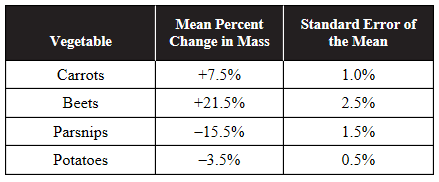
(a) Explain why some of the vegetables would have a positive percent change in mass while others would have a negative percent change in mass during the course of the experiment.
(b) Construct an appropriately labeled graph that shows the mean percent change in mass for each vegetable. Include 95% confidence intervals.

(c) Analyze the data to determine which vegetable has a water potential closest to the water potential of the 0.35 molar sucrose solution used in the experiment. Justify your answer with evidence from the experiment.
(d) It is determined that the sugar content in each vegetable is the major determinant of the vegetable’s water potential. Turnips have a higher sugar content than carrots but a lower sugar content than beets. If the experiment was repeated and included turnip cubes, predict the percent change in mass for the turnip cubes. Justify your prediction with evidence from the experiment.
Practice Questions
Multiple-Choice
Questions 1–3
Catalase, an enzyme found in aerobic organisms, catalyzes the following reaction:

A filter paper disk is saturated with the enzyme catalase and then placed at the bottom of a beaker of H2O2. As the reaction proceeds, oxygen bubbles will cling to the paper and eventually the paper will float to the top of the liquid. By measuring the time it takes for the catalase-saturated disk to float, one can compare the relative rates of decomposition of H2O2 under different experimental conditions.
An experiment was performed using catalase extracted from potatoes, with varying concentrations of H2O2. Multiple trials were conducted, and the means and the standard errors of the mean are shown in the following table:
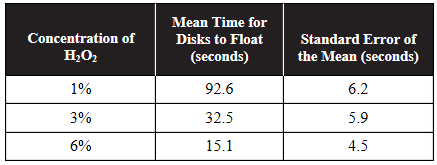
1. Which of the following would be a suitable control for this experiment?
(A) changing the temperature of the H2O2 in one of the beakers
(B) changing the solution the paper disk is soaked in from catalase to water in one of the beakers
(C) changing the source of the catalase from potato to liver
(D) changing the pH of the H2O2 in one of the beakers
2. Predict what would happen if the catalase solution was boiled before performing the experiment, and justify your prediction.
(A) The average time for the disks to float would increase because boiling denatured the enzymes.
(B) The average time for the disks to float would increase because enzyme-catalyzed reactions are always slower at higher temperatures.
(C) The average time for the disks to float would decrease because boiling increased the number of molecular collisions between the enzymes and substrates.
(D) The average time for the disks to float would increase because enzyme-catalyzed reactions are always faster at higher temperatures.
3. A student graphs this data, showing 95% confidence intervals. Based on the 95% confidence intervals, which concentrations of enzyme are least likely to have statistically significant differences?
(A) 1% and 3%
(B) 1% and 6%
(C) 3% and 6%
(D) None of the enzyme concentrations used are likely to have statistically significant differences.
(A) adding a cofactor of BCR-ABL
(B) adding a coenzyme of BCR-ABL
(C) adding a competitive inhibitor of BCR-ABL
(D) adding a transcription factor of BCR-ABL
Questions 5–7
Refer to the following figure.

5. Which of the following represents the activation energy of an enzyme-catalyzed reaction?
(A) A
(B) B
(C) C
(D) D
6. Which of the following represents the activation energy of an uncatalyzed reaction?
(A) A
(B) B
(C) C
(D) D
7. Which of the following represents the overall free energy change in the reaction?
(A) A
(B) B
(C) C
(D) D
(A) Enzymes decrease the overall free energy change of the reaction.
(B) Enzymes decrease the activation energy of the reaction.
(C) Enzymes increase the free energy of the reactants of the reaction.
(D) Enzymes increase the free energy of the products of the reaction.
9. Which of the following correctly describes the differences between competitive inhibitors and noncompetitive inhibitors?
(A) Competitive inhibitors bind to the active site of the enzyme; noncompetitive inhibitors bind to the allosteric site of the enzyme.
(B) Competitive inhibitors bind to the substrate; noncompetitive inhibitors bind to the products.
(C) The effects of a noncompetitive inhibitor can be mitigated by adding large amounts of substrate.
(D) Competitive inhibitors increase the rate of enzyme-catalyzed reactions; noncompetitive inhibitors slow the rate of enzyme-catalyzed reactions.
10. Which of the following statements about enzymes is true?
(A) Enzymes can change endergonic reactions into exergonic reactions.
(B) Both proteins and RNA can have catalytic functions.
(C) Enzymes always function optimally at a pH of 7.
(D) Enzymes are consumed during chemical reactions.
Short Free-Response
11. Enzymes are important biological molecules.
(a)Describe how an enzyme interacts with a substrate.
(b)Explain the difference between competitive inhibitors and allosteric inhibitors of enzymes.
(c)An enzyme has its maximum efficiency at an optimum temperature of 25° Celsius. Predict what effect a decrease in temperature to 5° Celsius would have on the enzyme’s efficiency.
(d)Justify your prediction from part (c).
12. The enzyme catalase breaks down hydrogen peroxide into water and oxygen, as shown in this equation:

An experiment was performed to measure the amount of oxygen bubbles produced at two different temperatures. The data are shown in the table.
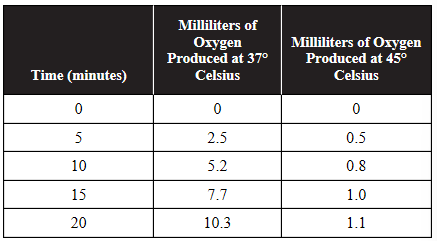
(a) Calculate the rate of the enzyme-catalyzed reaction at both temperatures for the final 10 minutes of the experiment.
(b) Predict which temperature (37°C or 45°C) is closer to the optimum temperature for this enzyme.
(c) Justify your prediction from part (b) using the data provided.
(d) In a follow-up experiment, the reaction was performed at a temperature of 50°C and no oxygen was produced. Explain why the enzyme would not function at 50°C.
Long Free-Response
13. Amylase is an enzyme that catalyzes the breakdown of amylose into its glucose subunits. The activity of amylase was measured at 37° Celsius and a pH of 7, both of which are optimum conditions for the activity of this enzyme. The production of glucose was measured both with and without the presence of compound X. Data are shown in the following table:
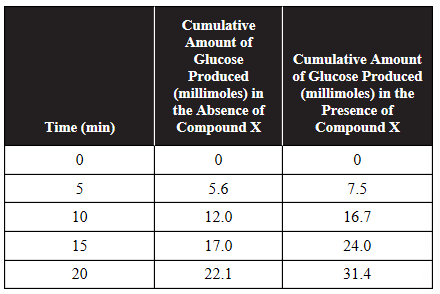
(a) On the axes provided, construct an appropriately labeled graph of this data.

(b) Based on the data and your graph from part (a), identify compound X as either: a cofactor, a competitive inhibitor, or a noncompetitive inhibitor of amylase. Justify your answer with evidence from the data.
(c) Construct an additional line on your graph from part (a) that represents your prediction as to the expected experimental results at a temperature of 10° Celsius in the absence of compound X.
(d) Explain your prediction from part (c), stating why you placed the additional line where you did.
Practice Questions
Multiple-Choice
1. In prokaryotes, where in the cell do the light-dependent reactions of photosynthesis occur?
(A) on the thylakoid membrane
(B) on the plasma membrane
(C) in the cytoplasm
(D) in the nucleoid region
Questions 2 and 3
A scientist, who is studying photosynthesis, places a plant in an environment where the oxygen atoms in carbon dioxide are labeled with radioactive 18O but the oxygen atoms in water have nonradioactive 16O.
2. Based on this scenario, predict which product of photosynthesis will contain radioactive 18O.
(A) NADPH
(B) glucose
(C) oxygen gas
(D) ATP
3. Based on this scenario, predict which product of photosynthesis will contain nonradioactive 16O.
(A)NADPH
(B)glucose
(C)oxygen gas
(D)ATP
4. Which of the following lists the three major parts of the light-independent reactions (the Calvin cycle)?
(A) carbon fixation, electron transport chain, reduction
(B) carbon fixation, reduction, production of ATP
(C) carbon fixation, reduction, regeneration of RuBP
(D) reduction, regeneration of RuBP, electron transport chain
5. Which of the following correctly lists the products of the light-dependent reactions?
(A) ADP, NADP+, oxygen
(B) ATP, NADPH, oxygen
(C) G3P, ADP, NADP+
(D) G3P, ATP, NADPH
6. Which of the following correctly lists the products of the Calvin cycle?
(A) ADP, NADP+, oxygen
(B) ATP, NADPH, oxygen
(C) G3P, ADP, NADP+
(D) G3P, ATP, NADPH
7. Which of the following statements correctly identifies the locations of the major parts of photosynthesis in plant cells?
(A) Light-dependent reactions occur in the stroma; light-independent reactions occur in the thylakoid.
(B) Light-dependent reactions occur in the matrix; light-independent reactions occur in the thylakoid.
(C) Light-dependent reactions occur in the thylakoid; light-independent reactions occur in the matrix.
(D) Light-dependent reactions occur in the thylakoid; light-independent reactions occur in the stroma.
8. If a thylakoid membrane is punctured so that molecules can freely flow between the thylakoid and the stroma, which of the following processes of photosynthesis will be most directly affected?
(A) the formation of G3P
(B) the generation of a proton gradient
(C) the absorption of light
(D) the fixation of carbon
9.Which of the following best describes a relationship between the light-dependent reactions and the Calvin cycle?
(A) The light-dependent reactions supply the Calvin cycle with oxygen, and the Calvin cycle returns carbon dioxide to the light-dependent reactions.
(B) The light-dependent reactions supply the Calvin cycle with ATP, and the Calvin cycle returns ADP to the light-dependent reactions.
(C) The light-dependent reactions supply the Calvin cycle with carbon dioxide, and the Calvin cycle returns oxygen to the light-dependent reactions.
(D) The light-dependent reactions supply the Calvin cycle with NADP+, and the Calvin cycle returns NADPH to the light-dependent reactions.
10. In the light-dependent reactions, the final electron acceptor in the electron transport chain is
(A) oxygen.
(B) water.
(C) NAD+.
(D) NADP+.
Short Free-Response
11. The sea slug Elysia crispata eats photosynthetic algae. However, after consuming the algae, the chloroplasts from the algae are incorporated into the sea slug’s own cells, give the sea slug a green color, and remain functional for up to four months. This phenomenon is called kleptoplasty.
(a)Describe the role of photosynthetic algae in ecosystems.
(b)Explain why kleptoplasty would give Elysia crispata a survival advantage.
(c)An oil spill on the surface of the water reduces the intensity of light in Elysia crispata’s habitat. Predict the effect this would have on Elysia crispata’s survival.
(d)Justify your prediction from part (c).
12. The light-dependent and light-independent reactions of photosynthesis exchange materials and are interdependent, as shown in the following figure.
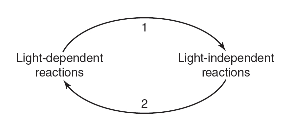
(a) Identify the molecules the light-dependent reactions provide to the light-independent reactions. Label arrow 1 with those molecules.
(b) Identify the molecules the light-independent reactions return to the light-dependent reactions. Label arrow 2 with those molecules.
(c) An inhibitor of the enzyme Rubisco is added to a plant cell. Explain which part of photosynthesis would be most directly affected by this inhibitor.
(d) A student claims that the light-independent reactions of photosynthesis would stop if a plant was kept in the dark for a long period of time. Use your knowledge about photosynthesis to support the student’s claim.
Long Free-Response
13. The following graph shows the absorption spectrum for the pigments chlorophyll a, chlorophyll b, and carotenoids.
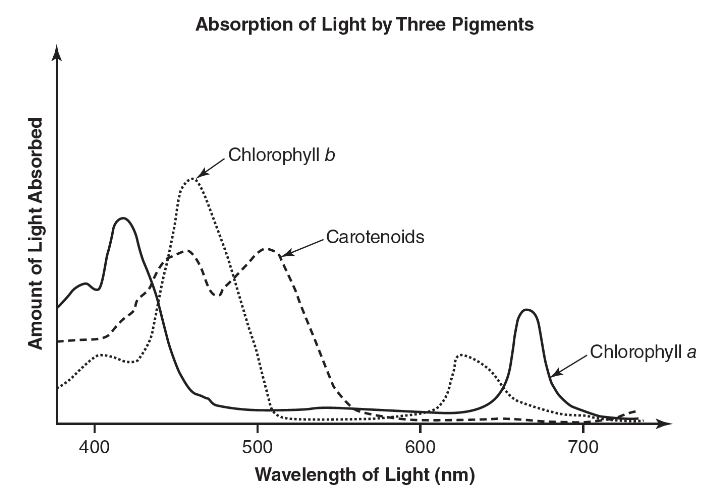
The following table shows the wavelengths of different colors of visible light.
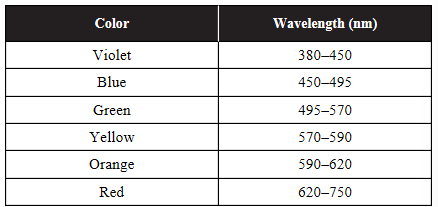
(a) For each of the three pigments, identify the color of light that will be most absorbed by that pigment. Use the graph to justify your answer.
(b) A mutation causes a plant to lose its ability to produce the pigments chlorophyll a and b. A student wants to design an experiment to study the rate of photosynthesis in the plant with this mutation. Identify an appropriate control for the experiment. Identify the independent and dependent variables in the experiment.
(c) The following figure graphs the rate of photosynthesis (as measured by oxygen production) in control plants and in plants with the mutation described in part (b).
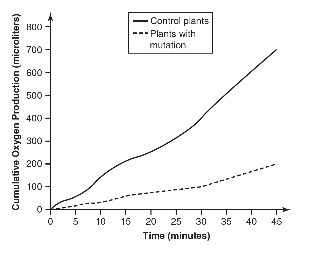
Calculate the rate of photosynthesis in both sets of plants during the first 30 minutes of the experiment.
(d) Plants that use carotenoids as their primary photosynthetic pigment are grown under three different wavelengths of light: 450 nm, 500 nm, and 550 nm. Predict which group of plants will perform the least amount of photosynthesis, and justify your prediction.
Practice Questions
Multiple-Choice
1. What is the primary purpose of fermentation?
(A) to generate ATP
(B) to generate pyruvate
(C) to generate NAD+
(D) to generate carbon dioxide
2. Which of the following processes does NOT release carbon dioxide?
(A) glycolysis
(B) oxidation of pyruvate
(C) Krebs cycle
(D) alcohol fermentation
3. Which of the following statements about glycolysis is NOT correct?
(A) Glycolysis occurs in the cytosol.
(B) Glycolysis can be carried out by all living organisms.
(C) The enzymes of glycolysis are highly conserved.
(D) Glycolysis produces a proton gradient.
4. A mutation in mitochondrial DNA causes the creation of a pore in the mitochondrial membrane through which protons can freely pass. Which of the following processes would most likely be disrupted by this mutation?
(A) glycolysis
(B) Krebs cycle
(C) chemiosmosis
(D) fermentation
5. During oxidative phosphorylation, ____________ is ____________, and oxygen is ____________.
(A) NADH; oxidized; produced
(B) NADH; oxidized; reduced
(C) NAD+; reduced; oxidized
(D) NAD+; reduced; produced
6. Which of the following processes produce ATP?
(A) glycolysis, oxidation of pyruvate, Krebs cycle
(B) glycolysis, Krebs cycle, chemiosmosis
(C) glycolysis, Krebs cycle, fermentation
(D) oxidation of pyruvate, Krebs cycle, fermentation
7. What is the role of oxygen in cellular respiration?
(A) to combine with carbon and electrons to form carbon dioxide
(B) to combine with protons and electrons to form water
(C) to remove carbon from glucose to form pyruvate
(D) to remove carbon from pyruvate to form alcohol
8. Where are the electron transport chain and ATP synthase located?
(A) in the cytosol
(B) on the outer membrane of the mitochondria
(C) on the inner membrane of the mitochondria
(D) in the mitochondrial matrix
9. Which of the following choices correctly describes the flow of electrons in cellular respiration?
(A) glucose → Krebs cycle → oxygen → NAD+
(B) glucose → NAD+ → electron transport chain → oxygen
(C) glucose → electron transport chain → pyruvate → oxygen
(D) glucose → NAD+ → electron transport chain → carbon dioxide
10. Cyanide is a poison that blocks the movement of electrons down the electron transport chain. Which of the following would be the most immediate result of cyanide poisoning?
(A) No pyruvate would be produced.
(B) No NADH would form.
(C) No ATP would be produced.
(D) Chemiosmosis would not occur.
Short Free-Response
11. NAD+ has an important role as an electron carrier in glycolysis.
(a) Identify the process of aerobic cellular respiration during which a cell replenishes its supply of NAD+.
(b) Identify the process of anaerobic respiration during which a cell replenishes its supply of NAD+.
(c) If a cell’s supply of NAD+ ran out, predict the effect that would have on glycolysis within that cell.
(d) Justify your prediction from part (c).
12. In eukaryotes, ATP synthase is found in the inner membrane of the mitochondria. In prokaryotes, which do not have mitochondria, it is found on infoldings of the cell membrane.
(a) Make a claim as to why ATP synthase is found on the cell membrane in prokaryotes.
(b) Justify your claim from part (a) using your knowledge of how ATP synthase works.
(c) Explain why ATP synthase would not be effective if it was found in the cytosol of a cell.
(d) Describe how the structure of the mitochondria allows for the formation of a proton gradient.
Long Free-Response
13. Saccharomyces cerevisiae (also known as baker’s yeast) is a eukaryotic organism. A solution containing 5% yeast and 10% glucose is placed in a transfer pipette. A weight is placed on the transfer pipette, and the apparatus is placed in water in a large test tube, as shown in the following figure.
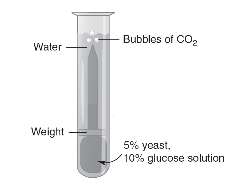
This process is repeated two more times, and each test tube is placed in a beaker of water at different temperatures (5° Celsius, 20° Celsius, and 35° Celsius). To measure the amount of cellular respiration, the cumulative number of bubbles of carbon dioxide released over a 10-minute period is recorded. The data are shown in the following table.

(a) Identify the independent variable and the dependent variable in this experiment.
(b) On the axes provided, construct an appropriately labeled graph of the experimental data.

(c) Calculate the average rate of carbon dioxide production per minute at each temperature.
(d) A fourth experimental apparatus is placed in a beaker of water at a temperature of 10° Celsius. Add a line to your graph from part (b) that predicts the rate of cellular respiration at 10° Celsius. Justify your prediction.
Practice Questions
Multiple-Choice
1. Auxin is a plant hormone that triggers cell division. A mutation occurs that deletes the gene for the auxin receptor. Which of the following is the most likely result of this mutation?
(A) The cells will still divide but at a faster rate.
(B) The cells will not be able to divide.
(C) The cells will develop a new receptor for the signaling molecule.
(D) The cells will not be affected by the lack of the auxin receptor.
2. Cortisol is a hormone produced in response to stress. Hunger is a stressor that can increase cortisol levels. Which of the following is most likely an effect of increased cortisol levels in response to hunger?
(A) increased activation of the immune response
(B) increased storage of calcium in bones
(C) increased reabsorption of water by the kidneys
(D) increased hydrolysis of glycogen to glucose
3. How do small ligands move between plant cells?
(A) Receptor proteins on plant cell membranes transport the ligands.
(B) Ligands pass through plasmodesmata that connect plant cells.
(C) Ligands can pass through the plant cell membrane unassisted.
(D) Active transport transfers ligands across the plant cell wall.
4. How do growth factors stimulate cell division?
(A) Growth factors bind to multiple cells, grouping them in multicellular structures.
(B) Growth factors bind to cyclic AMP, removing it from the cytosol.
(C) Growth factors bind to cell membrane receptors, triggering a signal transduction pathway.
(D) Growth factors bind to cell membrane phospholipids, which results in increased cell division.
5. In some autoimmune disorders, the body produces antibodies that bind to cell surface receptors on target cells, blocking them from interacting with other molecules. Which of the following is the most likely effect of the binding of the antibodies to the receptors?
(A) increased stimulation of the target cell
(B) the target cell’s inability to respond to ligands
(C) no effect on the target cell
(D) stimulation of gene expression in the target cell
6. Which of the following best describes the roles of calcium ions and cyclic AMP in the signal transduction process?
(A) They act as ligands.
(B) They act as receptor proteins.
(C) They act as secondary messengers.
(D) They act as protein kinases.
7. Which of the following removes phosphate groups from other molecules?
(A) cyclic AMP
(B) protein kinase
(C) protein phosphatase
(D) adenylyl cyclase
8. The hormone insulin travels through the circulatory system to reach target cells. Insulin is involved in which type of cell signaling?
(A) autocrine signaling
(B) juxtacrine signaling
(C) paracrine signaling
(D) endocrine signaling
9. Neurotransmitters travel short distances across synapses. This is an example of which type of signaling?
(A) autocrine signaling
(B) juxtacrine signaling
(C) paracrine signaling
(D) endocrine signaling
10. Which of the following is the most likely reason why some cells do not respond to certain ligands?
(A) Nonresponsive cells lack cyclic AMP.
(B) Nonresponsive cells lack receptors for the ligand.
(C) Nonresponsive cells lack the gene for the ligand.
(D) Nonresponsive cells cannot metabolize the ligand.
Short Free-Response
11. The ligands in signal transduction pathways may be hydrophobic or hydrophilic.
(a) Describe where in a cell the receptors for hydrophilic ligands and the receptors for hydrophobic ligands are located.
(b) Explain why hydrophobic ligands can cross the cell membrane unassisted.
(c) A mutation in the gene for adenylyl cyclase renders the enzyme ineffective. Predict the effect this would have on the cell.
(d) Justify your prediction from part (c).
12. An experiment is performed to measure how different cell types respond to a hormone that causes cells to absorb glucose from their environment. Four different cell types (A, B, C, and D) are used. At the start of this experiment, there are eight Petri dishes, each of which contains 100 millimolar glucose solution. Two dishes each contain cell type A, two dishes contain cell type B, two dishes contain cell type C, and the final two dishes contain cell type D, as illustrated in the following figure.
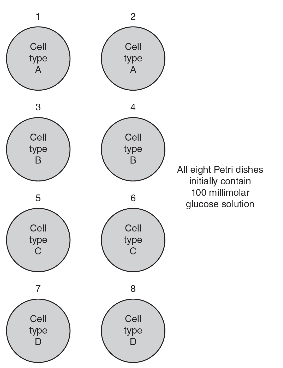
The hormone is added to four of the Petri dishes, one of each cell type. Glucose levels are measured in all eight Petri dishes 30 minutes after the addition of the hormone, and those glucose levels are listed in the following table.
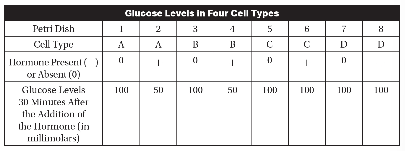
(a) Describe the most likely reason why cell types C and D did not respond to the presence of the hormone.
(b) Identify the function of Petri dishes 1, 3, 5, and 7 in the experimental procedure.
(c) A molecule is added to Petri dish 4 before the hormone is added. This molecule irreversibly binds to this hormone, preventing the hormone from binding to any receptor. The hormone is then added to Petri dish 4. Predict the effect this molecule will have on the glucose concentration in Petri dish 4 at 30 minutes after the addition of the hormone.
(d) Justify your prediction from part (c).
Long Free-Response
13. A signaling pathway for adrenaline is shown in the following diagram.
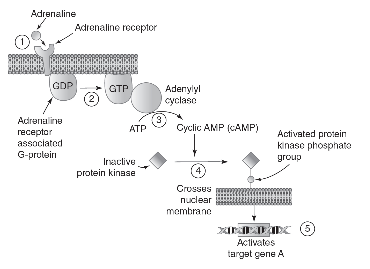
Researchers wanted to measure the effects of three different molecules on the adrenaline signaling pathway. Data are shown in the following table.

(a) Describe the parts of the cell signaling process that are represented in each of the five numbered steps in the diagram.
(b) Identify the control, the independent variable, and the dependent variables in this experimental procedure.
(c) Analyze the data, and identify which molecule(s) most likely interferes with the enzyme adenylyl cyclase.
(d) Cyclic AMP–dependent phosphodiesterase is an enzyme that breaks down cyclic AMP. Predict the numbered step in the diagram that would be most directly affected by adding cAMP-dependent phosphodiesterase to the cell. Justify your prediction.
Practice Questions
Multiple-Choice
1. A chemotherapy drug stops the replication of DNA. During which stage of the cell cycle would this drug have the greatest effect?
(A) G0
(B) G1
(C) G2
(D) S
2. A cell has reached full maturity, is fully differentiated, and no longer divides. Which of the following describes this stage of the cell cycle?
(A) G0
(B) G1
(C) G2
(D) S
3. Which stage of mitosis has twice as many chromosomes at its end as it had at its beginning?
(A) prophase
(B) metaphase
(C) anaphase
(D) telophase
4. During which stage of mitosis do the centromeres of chromosomes attach to spindle fibers and line up in a single column in the center of the cell?
(A) prophase
(B) metaphase
(C) anaphase
(D) telophase
5. A researcher measures the number of cells in each phase of the cell cycle. The data are shown in the following table. Approximately, what percentage of these cells are in interphase?
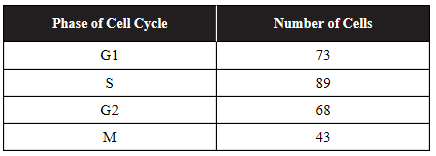
(A) 16%
(B) 33%
(C) 52%
(D) 84%
6. Which process best describes what occurs when soft tissue between the fingers dies during embryonic development?
(A) apoptosis
(B) DNA replication
(C) mitosis
(D) cytokinesis
7.During which process are the cytoplasm (and its cellular contents) divided between daughter cells?
(A) apoptosis
(B) DNA replication
(C) mitosis
(D) cytokinesis
8. Which of the following is a correct statement?
(A) Cancer cells exhibit anchorage dependence.
(B) Somatic cells exhibit density-dependent inhibition.
(C) Somatic cells spend most of their time in mitosis.
(D) Cancer cells exhibit density-dependent inhibition.
9. Which of the following best describes a role of mitosis?
(A) Mitosis distributes cytosol between the daughter cells.
(B) Replication of DNA occurs during mitosis.
(C) Replication of cell organelles occurs during mitosis.
(D) Mitosis distributes genetic material between the daughter cells.
10. During which phase of the cell cycle is a cleavage furrow or cell plate formed?
(A) interphase
(B) mitosis
(C) cytokinesis
(D) G0
Short Free-Response
11.Lectin is a molecule commonly found in legumes. Colchicine is a molecule that inhibits the formation of spindle fibers. An experiment was performed to observe the effects of lectin and colchicine on dividing cells. A total of 300 cells were observed for each treatment. Partial results of the experiment are shown in the following table.

(a) Describe the effect of adding lectin to the cells.
(b) Identify the independent variable and the dependent variable in this experiment.
(c) Based on the data presented, predict the most likely effects of adding only colchicine to the cells.
(d) Justify your prediction from part (c).
12. The following figure represents the concentrations of two different molecules (cyclin and cyclin-dependent kinase) during the cell cycle, and the arrow indicates the start of mitosis.
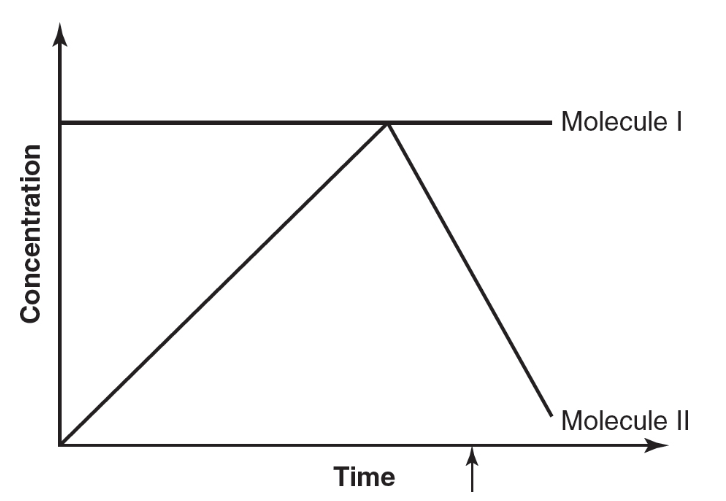
(a) Cell division can be described as having three major events: replication of chromosomes, alignment of chromosomes, and separation of chromosomes. Describe the stages of the cell cycle during which each of these three major events occurs.
(b) In the figure, which molecule (cyclin or cyclin-dependent kinase) is represented by the line labeled “Molecule I”? Which molecule (cyclin or cyclin-dependent kinase) is represented by the line labeled “Molecule II”?
(c) Explain why mitosis starts at the point indicated by the arrow in the figure.
(d) A cancer cell has a mutation that results in the constant production of Molecule II. Explain how the process of mitosis might be affected by this mutation.
Long Free-Response
13. A student wants to test whether treating onion root cells with caffeine will significantly increase the number of cells in mitosis. Two groups of onions are grown: one group received distilled water, and the other received distilled water with caffeine. The root tips of both groups are harvested and stained, and the number of cells in interphase and mitosis in each group is counted. The expected and observed data are shown in the following table.

(a) State the null hypothesis for this experiment.
(b) Identify the independent variable and the dependent variable.
(c) Use the chi-square equation and a p-value of 0.05 to analyze the data. Determine if there is a statistically significant difference between the two groups of onions.
(d) Justify your conclusion from part (c).
Practice Questions
Multiple-Choice
1. Which of the following correctly describes the products of meiosis?
(A) two genetically identical diploid cells
(B) two genetically different diploid cells
(C) four genetically identical haploid cells
(D) four genetically different haploid cells
2. An organism’s diploid number is 28. Which of the following is a correct statement about this organism?
(A) Its somatic cells would have 14 chromosomes, and its gametes would have 28 chromosomes.
(B) Its somatic cells would have 28 chromosomes, and its gametes would have 14 chromosomes.
(C) Both its somatic cells and its gametic cells would have 14 chromosomes.
(D) Both its somatic cells and its gametic cells would have 28 chromosomes.
3. Which of the following stages of meiosis generates genetic diversity?
(A) prophase I
(B) prophase II
(C) anaphase I
(D) anaphase II
4. Independent assortment of chromosomes occurs during which stage of meiosis?
(A) metaphase I
(B) metaphase II
(C) telophase I
(D) telophase II
5. Which of the following is a correct statement about meiosis?
(A) DNA replication occurs once, and there is one round of cell division.
(B) DNA replication occurs twice, and there is one round of cell division.
(C) DNA replication occurs once, and there are two rounds of cell division.
(D) DNA replication occurs twice, and there are two rounds of cell division.
6. How does the frequency of recombination events between genes that are close together on the same chromosome compare to the frequency of recombination events between genes that are far apart on the same chromosome?
(A) Genes that are close together on the same chromosome will recombine less frequently than genes that are far apart.
(B) Genes that are close together on the same chromosome will recombine more frequently than genes that are far apart.
(C) Genes that are close together on the same chromosome will recombine at the same rate as genes that are far apart.
(D) Genes that are on the same chromosome never have recombination events between them.
7. Which of the following statements correctly describes a difference between mitosis and meiosis?
(A) Mitosis produces four daughter cells, whereas meiosis produces two daughter cells.
(B) Mitosis produces genetically different cells, whereas meiosis produces genetically identical cells.
(C) Mitosis produces somatic cells, whereas meiosis produces gametes.
(D) Mitosis produces haploid cells, whereas meiosis produces diploid cells.
8. Aneuploidies can result from errors during which stage of meiosis?
(A) prophase I
(B) metaphase I
(C) anaphase I
(D) telophase I
Questions 9 and 10
The following figure is a karyotype, a picture that shows the chromosomes found in a somatic human cell.
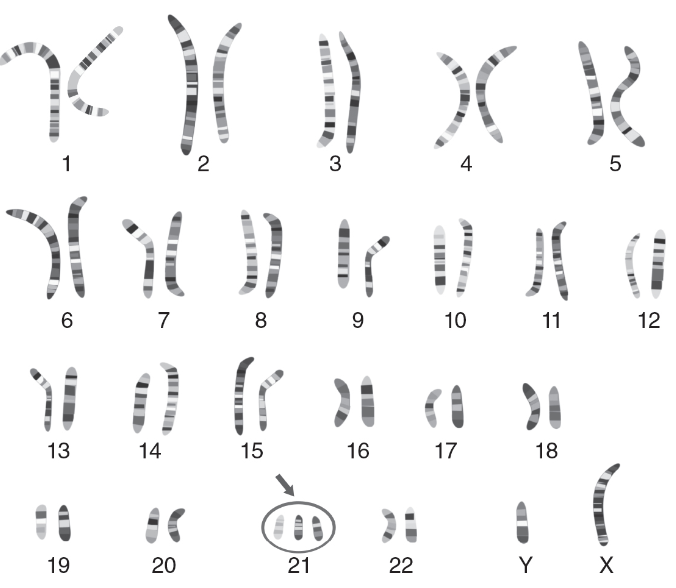
9. Which of the following best describes the condition shown in the circle?
(A) trisomy
(B) haploidy
(C) monosomy
(D) diploidy
10. Which of the following was the most likely cause of the condition shown in the circle?
(A) translocation
(B) independent assortment
(C) nondisjunction
(D) genetic recombination
Short Free-Response
11. Genes A, B, and C are on the same chromosome. The frequencies of genetic recombination events between the genes is shown in the following table.

(a) Using this data and the following template, construct a genetic map of these three genes.

(b) Explain your placement of the three genes on the genetic map from part (a).
(c) A new gene, D, is discovered on the same chromosome. A and D have a recombination frequency of 10%. B and D have a recombination frequency of 35%. On your genetic map from part (a), draw an additional line to represent the relative location of gene D on the chromosome.
(d) A different chromosome in the organism has genes, M, N, O, and P. One copy has the alleles MNOP. The other copy of the chromosome has the alleles mnop. If genetic recombination occurred between genes N and O, explain the two possible gametes that would be produced by this crossing-over event.
12. An organism has a diploid number of six chromosomes.
(a) Determine the number of chromosomes in each of the four cells that would be produced upon the completion of meiosis II.
(b) Based on your answer to part (a), explain why the cells would each have that number of chromosomes at the end of meiosis II.
(c) A nondisjunction event occurred during anaphase II. Predict the number of chromosomes that would be found in each of the four cells after this nondisjunction event.
(d) Justify your prediction from part (c).
Long Free-Response
13. An organism has the two chromosomes shown in the following figure.

A student claims that exposure to UV light prior to meiosis will increase the frequency of genetic recombination during meiosis. Gamete-producing cells from this organism are placed into two groups. One group is not exposed to UV light, and the other group is exposed to UV light prior to undergoing meiosis. The gametes produced at the end of meiosis and the frequencies of those gametes are shown in the following table.

(a) Identify and explain the stage of meiosis during which genetic recombination occurs.
(b) Identify the independent variable and the dependent variable in this experiment.
(c) Using the data, provide reasoning to support the student’s claim.
(d) The experiment is repeated with increased exposure to UV light (for the cells that were exposed to UV light). Predict how this change will affect the recombination frequencies. Justify your prediction.
Practice Questions
Multiple-Choice
1. Mendel’s law of independent assortment is a result of
(A) the random nature of fertilization of ova by sperm.
(B) the random way homologous chromosomes undergo genetic recombination in meiosis.
(C) the random way homologous chromosomes line up in metaphase I of meiosis.
(D) the random nature of molecular movement at high temperatures.
2. The term hybrid can also mean _________.
(A) homozygous
(B) heterozygous
(C) haploid
(D) diploid
3. In peas, round (R) peas are dominant and wrinkled (r) peas are recessive. A plant with an unknown genotype for this trait has round peas. Which of the following results of a test cross would support the hypothesis that the genotype of the plant with the round peas is heterozygous?
(A) 100% round offspring
(B) 75% round offspring and 25% wrinkled offspring
(C) 50% round offspring and 50% wrinkled offspring
(D) 100% wrinkled offspring
4. In pea plants, smooth (S) pods are dominant and constricted (s) pods are recessive. Which of the following is a correct statement?
(A) A genotype of SS would result in the constricted pod phenotype.
(B) A genotype of Ss would result in the constricted pod phenotype.
(C) Constricted pods would always be homozygous.
(D) Smooth pods would always be homozygous.
5. Round peas are dominant to wrinkled peas. Smooth pea pods are dominant to constricted pea pods. Two pea plants that are heterozygous for both traits are crossed, and 800 offspring are produced. How many of the offspring are expected to have round peas and constricted pods?
(A) 450
(B) 150
(C) 50
(D) 0
6. A pea plant that is heterozygous for round peas and heterozygous for smooth pods is crossed with a pea plant that is heterozygous for round peas and has constricted pods. What fraction of the offspring are expected to have round peas and constricted pods? (Remember that round peas are dominant to wrinkled peas, and smooth pods are dominant to constricted pods.)

7. In humans, the gene for polydactyly (extra fingers or toes) is dominant over the gene for the typical number of fingers and toes. If a person who is heterozygous for polydactyly has children with a person with the typical number of fingers and toes, what is the probability that their first child will have polydactyly?
(A) 100%
(B) 50%
(C) 25%
(D) 0%
8. In the cross AaBbCc × AaBbCc, what is the probability of producing an offspring with the AABBCc genotype?

Questions 9 and 10
Rh positive (R) is a trait that is dominant over Rh negative (r). A woman, who is Rh positive, has a son, who is Rh negative.
9. Which of the following is a true statement about the mother?
(A) She must have the rr genotype.
(B) She must have the RR genotype.
(C) She must be heterozygous for the trait.
(D) She must have the same genotype as her son.
10. Which of the following is a true statement about the father of the woman’s son?
(A) He must have the RR genotype.
(B) He must have the Rr genotype.
(C) He must have the rr genotype.
(D) He may have either the Rr or the rr genotype.
Short Free-Response
11. Sickle cell disease is an autosomal recessive disorder. Homozygous recessive individuals have red blood cells that can assume a sickle shape when oxygen levels are low. These sickled blood cells can cause blockages in blood vessels, leading to pain and possibly fatal complications. Heterozygous individuals do not suffer the pain or complications from sickle cell disease and are more resistant to malaria than individuals with two nonsickle alleles. The following figure shows the pattern of inheritance of sickle cell disease through three generations of a family. Squares indicate males, circles indicate females, and shaded shapes indicate individuals who have sickle cell disease.
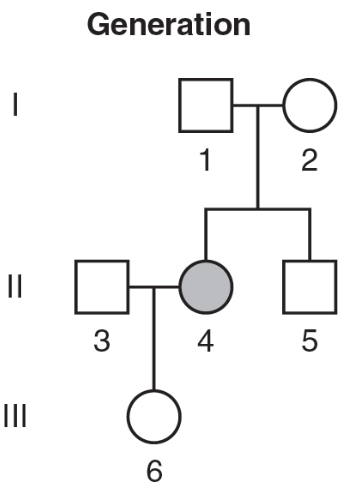
(a) Describe the genotype of individual I-2. Justify your answer with evidence from the pedigree.
(b) What is the genotype of individual III-6? Explain how you know her genotype.
(c) Create a Punnett square that represents the possible genotypes of the offspring of individuals 1 and 2 from generation I.
(d) Explain which genotype from this pedigree would provide an advantage in San Francisco (where the mosquito that carries malaria does not live) and which genotype would be most advantageous to survival in Haiti (where the mosquito that carries malaria is found).
12. Fur color in hamsters is determined by a single gene, with yellow fur color being dominant to white fur color. Inheriting two copies of the allele for yellow fur color is fatal, so all individuals with yellow fur are heterozygous.
(a) Determine the probability that the offspring of two hamsters with yellow fur would also have yellow fur.
(b) Construct a Punnett square that represents the two hamster parents from part (a), and use the Punnett square to explain your answer to part (a).
(c) A hamster population lives in an area covered with yellow-goldenrod-colored grasses. An unusually cold winter results in the death of all the yellow-goldenrod-colored grasses, so in the spring the area is covered only in white sand. Predict what would happen to the frequency of the allele for yellow fur color over time.
(d) Justify your prediction from part (c).
Long Free-Response
13. In pea plants, tall plant height is dominant over short. A new type of plant food (Supersize Food) is advertised to increase plant height. Two pea plants that are heterozygous for plant height are crossed, and the seeds that are produced are harvested. Half of the seeds are planted and grown in the presence of Supersize Food, and the other half of the seeds are planted and grown without Supersize Food. When the plants reach full maturity, the number of tall and short plants are recorded. The data are shown in the table.
 (a) Describe the proportions of tall and short plants that were expected to result from the cross. Use a Punnett square to support your answer.
(a) Describe the proportions of tall and short plants that were expected to result from the cross. Use a Punnett square to support your answer.
(b) Identify the independent variable and the dependent variable in this experiment. Identify one possible appropriate experimental constant.
(c) A student makes the claim that “there is no statistically significant difference between the plants grown in the presence or absence of Supersize Food.” Use the chi-square equation to analyze the data and evaluate this claim. Use a p-value of 0.05 for your analysis.
(d) A tall plant with an unknown genotype is crossed with a short plant. Predict the expected proportions of tall and short offspring if the tall plant is heterozygous. Justify your prediction.
Practice Questions
Multiple-Choice
1. Two genes that are close together on the same chromosome are said to be _______ and are _______ likely to be inherited together than _______ genes.
(A) linked; less; unlinked
(B) linked; more; unlinked
(C) unlinked; less; linked
(D) unlinked; more; linked
2. Sex-linked recessive traits in humans are _______ likely to be expressed in _______.
(A) less; males
(B) more; females
(C) more; males
(D) equally; both males and females
3. An example of a trait that involves multiple gene inheritance in plants is seed size. If seed size involves three genes (A, B, and C), in which each dominant allele contributes to increased seed size, which of the following genotypes would result in the smallest seed?
(A) AABBCC
(B) AaBBCc
(C) AaBbCC
(D) AaBbCc
4. Which of the following statements best explains the difference between nonnuclear inheritance and sex-linked inheritance?
(A) Females may pass on nonnuclear and sex-linked traits to both their sons and daughters, but only their sons may pass on nonnuclear traits to the next generation.
(B) Females may pass on nonnuclear and sex-linked traits to both their sons and daughters, but only their daughters may pass on nonnuclear traits to the next generation.
(C) Females may pass on sex-linked traits to their offspring, but they cannot pass on nonnuclear traits to their offspring.
(D) Females may pass on nonnuclear traits to their offspring, but they cannot pass on sex-linked traits to their offspring.
5. Two snowshoe hares (a type of rabbit) have the same genotype. During the winter, the hare that lives outdoors in the cold has white fur, but the hare that lives in a climate-controlled and warm environment has brown fur. This is an example of _______.
(A) sex-linkage
(B) multiple gene inheritance
(C) nonnuclear inheritance
(D) phenotypic plasticity
6. In Drosophila (fruit flies), females have two XX chromosomes, and males have one X chromosome and one Y chromosome. The eye color gene is located on the X chromosome, and the red-eyed allele is dominant to the white-eyed allele. A heterozygous, red-eyed female is mated with a white-eyed male. Which of the following is the most likely result in their offspring?
(A) All females are red-eyed, and all males are white-eyed.
(B) All females are red-eyed, 50% of males are red-eyed, and 50% of males are white-eyed.
(C) 50% of females are red-eyed, 50% of females are white-eyed, and all males are white-eyed.
(D) 50% of both sexes are red-eyed, and 50% of both sexes are white-eyed.
7. Sex determination in birds follows the ZW system, where males have two copies of the Z chromosome (ZZ) and females are heterozygous (ZW). A male bird (who is heterozygous for a trait on the Z chromosome) is mated with a female bird (who expresses the recessive phenotype for that trait). Which of the following best describes their most likely offspring?
(A) 25% males with the dominant phenotype, 25% males with the recessive phenotype, 25% females with the dominant phenotype, and 25% females with the recessive phenotype
(B) all males with the dominant phenotype and all females with the recessive phenotype
(C) 25% males with the dominant phenotype, 25% males with the recessive phenotype, and 50% females with the recessive phenotype
(D) 50% males with the dominant phenotype, 25% females with the dominant phenotype, and 25% females with the recessive phenotype
8. Cats with two X chromosomes are female, and cats with one X and one Y chromosome are male. The gene for fur color in cats is on the X chromosome: XB is the black allele and Xo is the orange allele. Cats who are heterozygous express the calico phenotype, with patches of black fur and patches of orange fur. A female calico cat is mated with a black male cat. Which of the following best describes the predicted ratios of their offspring?
(A) 1/2 of the offspring would be female calico cats, and 1/2 of the offspring would be male black cats.
(B) 1/4 of the offspring would be female black cats, of the offspring would be female calico cats, 1/4 of the offspring would be male black cats, and 1/4 of the offspring would be male orange cats.
(C) 1/2 of the offspring would be female black cats, and 1/2 of the offspring would be male calico cats.
(D) 1/2 of the offspring would be female black cats, 1/4 of the offspring would be male black cats, and 1/4 of the offspring would be male orange cats.
Questions 9 and 10
Refer to the figure, which shows a pedigree of an inherited trait.
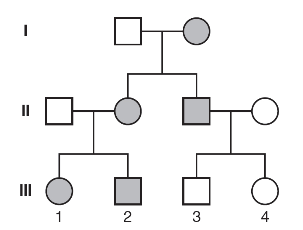
9. Based on this pedigree, which of the following most likely describes the inheritance of this trait?
(A) autosomal dominant
(B) autosomal recessive
(C) sex-linked recessive
(D) mitochondrial inheritance
10. If individual III-3 has a child with a woman who does not have the allele, what is the most likely probability that their child will have the trait?
(A) 0%
(B) 25%
(C) 50%
(D) 100%
Short Free-Response
11. Hemophilia is a sex-linked recessive disorder on the X chromosome. The following figure shows a portion of a pedigree of the descendants of Queen Victoria of England. Individuals with hemophilia are indicated by shading.
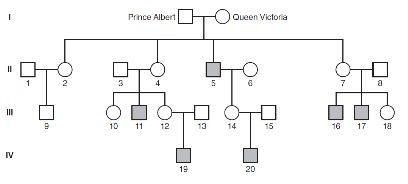
(a) Describe the genotype of individual 4 in generation II. Justify your answer with evidence from the pedigree.
(b) What is the genotype of individual 14 in generation III? Explain how you know her genotype.
(c) Create a Punnett square that represents the possible genotypes of the offspring of individuals 7 and 8 in generation II.
(d) Explain why the offspring of two closely related individuals are more likely to express recessive traits.
12. This pedigree shows the inheritance of a trait in three generations of a family.
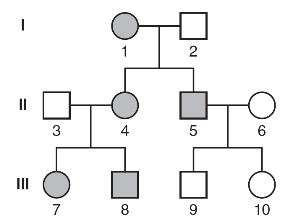
(a) Describe a likely mode of inheritance of this trait. Use evidence from the pedigree to justify your answer.
(b) Explain how a pedigree for a trait that is recessive would look different from a pedigree for a trait that is dominant.
(c) A student makes a claim that this pedigree indicates the trait is inherited through mitochondrial DNA. Evaluate this claim using evidence from the pedigree.
(d) Explain why the pattern of inheritance of an autosomal dominant trait is different from the pattern of inheritance of a mitochondrial trait.
Long Free-Response
13. In Drosophila (fruit flies), eye color is on the X chromosome. Male flies have an X and a Y chromosome, and female flies have two X chromosomes.
(a) A red-eyed male fly is mated with a white-eyed female fly. All the resulting female offspring have red eyes, and all the resulting male offspring have white eyes. Explain which trait, red eyes or white eyes, is dominant and why. Draw a Punnett square to support your answer.
(b) Scientists have discovered that white-eyed flies have a mutation in the enzyme TRY 2,3-dioxygenase (TDO2). TDO2 mutations prevent the accumulation of kynurenine, a compound associated with aging. White-eyed flies and red-eyed flies were raised under identical conditions, and the mean life span of both type of flies was recorded. Identify the independent variable and the dependent variable in that experiment.
(c) The data from the experiment described in part (b) are shown in the following table.

*Standard Error of the Mean
Evaluate the data to determine whether or not there is likely a statistically significant difference in the life spans of white-eyed and red-eyed flies based on this experiment.
(d) A nondisjunction event in meiosis leads to the production of a heterozygous red-eyed male fly with two X chromosomes and one Y chromosome. Predict the possible offspring from a mating between this male and a white-eyed female, and justify your answer.
Practice Questions
Multiple-Choice
1. The genome of a newly discovered virus has the following nucleotide composition: 22% guanine, 16% cytosine, 34% adenine, and 28% uracil. Based on the nucleotide composition, the genome of this virus is most likely made of which of the following?
(A) single-stranded DNA
(B) double-stranded DNA
(C) single-stranded RNA
(D) double-stranded RNA
2. Prokaryotic genomes are packaged into _________ chromosomes in the _________.
(A) circular; nucleoid region
(B) circular; nucleus
(C) linear; nucleoid region
(D) linear; nucleus
3. Energy is required to separate the two strands of the DNA double helix because of the hydrogen bonds between the base pairs. Based on the base pair content, which of the following would require the least amount of energy to separate the strands of DNA?
(A) 20% G, 20% C, 30% A, 30% T
(B) 30% G, 30% C, 20% A, 20% T
(C) 15% A, 15% T, 35% G, 35% C
(D) 25% G, 25% C, 25% A, 25% T
4. Which of the following correctly describes a structural difference between DNA and RNA?
(A) DNA has a five-carbon sugar; RNA has a four-carbon sugar.
(B) DNA has thymine; RNA has uracil.
(C) DNA has adenine; RNA has cytosine.
(D) DNA is typically single-stranded; RNA is typically double-stranded.
Questions 5 and 6
N-15, also known as heavy nitrogen, is an isotope of nitrogen that is heavier than the isotope that is typically found in nature, N-14. Conducting chemical reactions in the presence of different isotopes of nitrogen allow a scientist to follow nitrogen atoms in a metabolic pathway. In a classic experiment, Meselson and Stahl allowed parent DNA (containing N-15) to replicate in the presence of N-14.
5. After one round of DNA replication, which of the following results would support the statement “DNA replication is semiconservative”?
(A) All DNA molecules have one strand containing N-14 and one strand containing N-15.
(B) 50% of the DNA molecules only contain N-14, and 50% of the DNA molecules only contain N-15.
(C) All DNA molecules only contain N-15.
(D) All DNA molecules only contain N-14.
6. After two rounds of DNA replication, which of the following results would support the statement “DNA replication is semiconservative”?
(A) All DNA molecules have one strand containing N-14 and one strand containing N-15.
(B) 50% of the DNA molecules only contain N-14, and 50% of the DNA molecules only contain N-15.
(C) All DNA molecules only contain N-15.
(D) 50% of the DNA molecules contain only N-14, and 50% of the DNA molecules have one strand containing only N-15 and one strand containing only N-14.
(A) One stand of the double helix contains thymine, and the other strand contains uracil.
(B) Only G and C nucleotides appear on one strand of the double helix, and only A and T nucleotides appear on the other strand of the double helix.
(C) RNA polymerase can only synthesize RNA primers on one strand of the double helix.
(D) DNA polymerase can only add new nucleotides in the 5′ to 3′ direction.
8. The enzyme _________ unwinds the double helix of DNA, and the enzyme _________ relieves the supercoiling created by this unwinding.
(A) helicase; topoisomerase
(B) DNA polymerase; topoisomerase
(C) DNA polymerase; ligase
(D) helicase; ligase
9. The enzyme _________ adds new nucleotides to both the lagging and leading strand, and the enzyme _________ joins the discontinuous segments synthesized on the lagging strand.
(A) helicase; topoisomerase
(B) DNA polymerase; topoisomerase
(C) DNA polymerase; ligase
(D) helicase; ligase
10. Which of the following are small, circular pieces of extranuclear DNA that can be found in either prokaryotes or eukaryotes?
(A) Okazaki fragments
(B) RNA primers
(C) plasmids
(D) linear chromosomes
Short Free-Response
11. Reverse transcriptase is an enzyme that makes a complementary DNA copy of RNA in retroviruses. This DNA copy can then insert itself into the genome of the host cell. Reverse transcriptase has a higher error rate than DNA polymerase, which results in more mutations in the DNA copy of the RNA. Reverse transcriptase is not typically used by eukaryotic cells for any function.
(a) Describe which nucleotides you would expect to find in the genome of a virus that uses reverse transcriptase.
(b) The human immunodeficiency virus (HIV) contains RNA as its genetic material. Reverse transcriptase inhibitors have been shown to be effective in slowing the replication of HIV. Explain why reverse transcriptase inhibitors have few side effects in eukaryotic cells.
(c) Predict the rate of mutation in a retrovirus compared to that of a DNA virus.
(d) Justify your prediction from part (c).
12. An experiment is conducted to study the effect of a ligase inhibitor on DNA replication.
(a) Describe the function of ligase in DNA replication.
(b) Identify an appropriate control for this experiment.
(c) Predict which strand of the DNA would be most affected by a ligase inhibitor.
(d) Justify your prediction from part (c).
Long Free-Response
13. Polymerase chain reaction (PCR) uses a heat-stable DNA polymerase and repeated cycles of DNA replication to amplify specific sequences of DNA. Primers specific to the desired DNA sequences are used to direct DNA polymerase to the beginning of the sequence to be amplified. The following table shows the number of copies of the DNA sequence that exist at the end of each cycle.
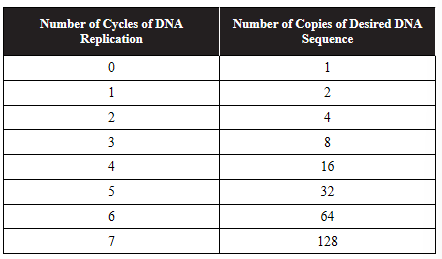
(a) Explain why a primer is needed to direct DNA polymerase to copy the desired sequence.
(b) Construct a graph of the data from the table.

(c) Analyze the data, and state the mathematical relationship between the number of cycles of PCR and the number of copies of the desired DNA sequence generated.
(d) Predict the minimum number of cycles required to generate 1,000 copies of the desired DNA sequence. Justify your prediction.
Practice Questions
Multiple-Choice
1. What would be the minimum number of nucleotides required to code for a protein made of 12 amino acids?
(A) 6
(B) 12
(C) 36
(D) 48
2. A scientist inserts a eukaryotic gene directly into a bacteria’s genome. However, the protein produced by the bacteria from the eukaryotic gene does not have the same amino acid sequence as the protein produced from the gene in eukaryotic cells. Which of the following best explains this?
(A) Prokaryotes and eukaryotes do not use the same genetic code, so the bacteria cannot decode the eukaryotic gene.
(B) Eukaryotic genes contain introns, which must be removed before translation; prokaryotes cannot remove introns.
(C) Prokaryotes do not have a nucleus and cannot perform transcription.
(D) Prokaryotes do not have rough endoplasmic reticulum, so they cannot translate eukaryotic genes.
3. Which of the following correctly represents the mRNA sequence that would be transcribed from the DNA sequence 3′ ACC GGT AAG TTC 5′?
(A) 3′ TGG CCA TTC AAG 5′
(B) 3′ UGG CCA UUC AAG 5′
(C) 5′ TGG CCA TTC AAG 3′
(D) 5′ UGG CCA UUC AAG 3′
4. What is the amino acid sequence that would be translated from the following gene? (Use Figure 16.4 to answer this question.)
3′ AAT CGT TTC AAT CAA 5′
(A) Asn-Arg-Phe-Asn-Gln
(B) Leu-Ala-Lys-Leu-Val
(C) Phe-Arg-Asn-Phe-Gln
(D) Gly-Ala-Lys-Gly-Val
5. Which of the following processes is most similar in prokaryotes and eukaryotes?
(A) alternative splicing of exons
(B) addition of a 3′ poly-A tail to mRNA
(C) addition of a 5′ GTP cap to mRNA
(D) transcription by RNA polymerase
6. The following figure depicts steps in the flow of genetic information in a eukaryotic cell.

During which step will spliceosomes remove introns?
(A) 1
(B) 2
(C) 3
(D) 4
7. The antibiotic tetracycline inhibits bacterial growth by blocking the binding of tRNAs to the ribosome. Which of the following processes is most directly affected by tetracycline?
(A) transcription
(B) exon splicing
(C) initiation of translation
(D) export of proteins from the cell
8. Why do retroviruses have a high mutation rate?
(A) RNA polymerase has a high error rate when reading viral genomes.
(B) DNA polymerase has a high error rate when reading viral genomes.
(C) Viruses use a different genetic code than prokaryotes and eukaryotes use.
(D) Reverse transcriptase has a high error rate.
9. Humans can generate over 1012 different antibody proteins, but humans have fewer than 25,000 genes. Which of the following best explains how this is possible?
(A) Humans acquire new antibody genes when they are infected with pathogens.
(B) Alternative splicing of exons can generate many different transcripts from the same gene.
(C) The error rate in RNA polymerase generates new transcripts for antibody proteins.
(D) Golgi bodies modify RNA transcripts to create new combinations.
10. Which of the following catalyzes the formation of peptide bonds during translation?
(A) RNA polymerase
(B) mRNA
(C) rRNA
(D) tRNA
Short Free-Response
11. Ehlers-Danlos syndrome (EDS) type IV is a result of a mutation in the COL3A1 gene, which results in the deletion of one of the exons in the procollagen transcript.
(a) Describe the location in the cell where the splicing of exons occurs.
(b) Explain the difference between exons and introns.
(c) Predict the effect of the EDS mutation on the structure of the procollagen protein.
(d) Justify your prediction from part (c).
12. A mutation results in the deletion of the TATA box in the promoter of a eukaryotic gene.
(a) Describe the function of the promoter in gene expression.
(b) Explain why promoter sequences are highly conserved in living organisms.
(c) The figure that follows shows the gene and the DNA surrounding it. Draw an “X” on the most likely location of the promoter of the gene.

(d) Explain how the deletion of the TATA box in the promoter would most likely affect the levels of protein produced by the gene.
Long Free-Response
13. The levels of mRNA and protein produced by three different genes (PDHA1, MBP, and INS) were measured in different tissues of the human body. The levels of mRNA and protein expression from these genes were compared to mRNA and protein expression from the gene POLR2A (RNA polymerase II subunit A, which is expressed in all human tissues). The results are shown in the table. “0” indicates that mRNA or protein were not detected in that tissue, and “+,” “++,” and “+++” indicate relatively low, medium, or high levels of mRNA or protein detected, respectively.

(a) Identify which gene was used as a control in this experiment.
(b) Explain why the gene you selected in part (a) would be an appropriate control for this experiment.
(c) Based on the data in the table, determine which of the genes (PDHA1, MBP, or INS) is most likely involved in glycolysis.
(d) INS is the insulin gene. Insulin is a hormone that is released when blood sugar levels are high. Predict the levels of INS mRNA and protein that would be found in cells in the pancreas when blood sugar levels are low. Justify your prediction.
Practice Questions
Multiple-Choice
1. A repressible operon in bacteria codes for the genes required to produce the amino acid serine. Serine functions as a corepressor for the operon. If serine is present in the bacteria’s environment, which of the following is most likely?
(A) increased digestion of serine
(B) increase in the levels of serine
(C) increased production of the repressor protein
(D) increased binding of the repressor protein to the operator
2.The arabinose operon is an inducible operon that codes for the genes required to digest the sugar arabinose. Arabinose functions as an inducer molecule for the operon. If arabinose is present in the bacteria’s environment, which of the following is most likely?
(A) increased digestion of arabinose
(B) increase in the levels of arabinose
(C) increased production of the repressor protein
(D) increased binding of the repressor protein to the operator
3. Which sequences in bacterial operons are noncoding sequences?
(A) operators and promoters only
(B) operators, promoters, and genes for regulatory proteins
(C) operators, promoters, and genes for structural proteins
(D) promoters, genes for regulatory proteins, and genes for structural proteins
4. Which of the following is a key difference between inducible operons and repressible operons?
(A) Inducible operons have promoter sequences, and repressible operons do not have promoter sequences.
(B) Inducible operons have operator sequences, and repressible operons do not have operator sequences.
(C) The repressor in an inducible operon can bind to the operator sequence on its own, but the repressor in a repressible operon requires a corepressor in order to bind to the operator.
(D) In inducible operons, RNA polymerase requires the presence of a corepressor in order to bind to the promoter; in repressible operons, RNA polymerase does not require a corepressor.
5. Under which of the following conditions will transcription of the lac operon be at its highest level?
(A) low glucose, low lactose
(B) low glucose, high lactose
(C) high glucose, low lactose
(D) high glucose, high lactose
6. Adding a methyl group to a DNA nucleotide is a type of _____________ and will make a DNA sequence much less likely to be transcribed.
(A) mutation
(B) epigenetic change
(C) aneuploidy
(D) transposition
7. Which of the following are proteins in eukaryotes that bind to regulatory switches and upregulate gene expression?
(A) activators
(B) repressors
(C) transcription factors
(D) mediators
8. Not every change in the DNA sequence results in a change in the amino acid sequence of a protein. Which of the following explains this?
(A) Each organism lives in a different environment, which changes the expression of its genes.
(B) The genetic code is redundant, and more than one codon codes for most amino acids.
(C) The proofreading function of ribosomes corrects changes in the DNA sequence.
(D) Differential gene expression adapts to these changes in the DNA sequence.
9. Which of the following does not affect the phenotype of an organism?
(A) the genes that are expressed
(B) the level at which genes are expressed
(C) the timing of gene expression
(D) the number of genes in the organism
10. Which of the following methods of horizontal transmission of genetic material would be most likely to lead to new variants of the COVID-19 virus?
(A) transformation
(B) transduction
(C) transposition
(D) conjugation
Short Free-Response
11. One way that organisms respond to changing environmental conditions is through the regulation of gene expression.
(a) Describe the function of operators and promoters in prokaryotes.
(b) Explain how the operator and repressor interact to control the expression of the inducible lac operon.
(c) Bacteria are placed in an environment that has low levels of glucose and high levels of lactose. Predict the level of expression of the lac operon in this environment.
(d) Justify your prediction from part (c).
12. A student conducts an experiment in an effort to determine whether a specific bacterial operon is inducible or repressible. The level of transcription of the operon was measured after the addition of different molecules to the bacteria’s environment. Data are shown in the table.

(a) Describe what, if any, effect levels of fructose have on the level of transcription of the operon.
(b) Describe what, if any, effect levels of lysine have on the level of transcription of the operon.
(c) Make a claim about whether this operon is more likely inducible or repressible.
(d) Justify your claim from part (c) using evidence from the experiment and your knowledge of inducible and repressible operons.
Long Free-Response
13. The human THY-1 gene (Thy-1 cell surface antigen) codes for a cell surface glycoprotein that is thought to function as a tumor suppressor in certain types of cancer. In order to find possible locations of enhancer sequences for the THY-1 gene, scientists performed a series of DNA deletion experiments. In the experiments, different deletions were made in areas that were suspected to function as possible enhancer sequences, and the levels of THY-1 transcription were measured after each deletion. The following diagram shows the sequences deleted. A, B, C, D, and E represent different DNA sequences. 1, 2, and 3 represent suspected enhancer sequences. P is the promoter of the THY-1 gene. An X represents the deletion of that portion of the DNA sequence.
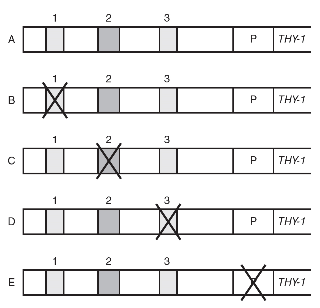
The levels of THY-1 transcription in each part of the experiment are shown in the graph.
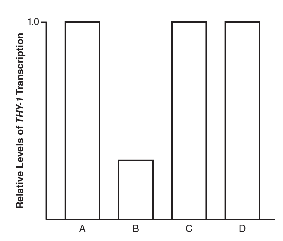
(a) Explain the function of enhancer sequences in eukaryotic gene expression.
(b) Identify which DNA sequence (A, B, C, D, or E) was the control in this experiment.
(c) Which sequence (1, 2, or 3) most likely functions as an enhancer sequence? Support your claim using evidence from the data.
(d)Predict the effects of the deletion of P, as shown in sequence E, and what the relative level of THY-1 transcription would be for E. Justify your prediction with evidence from the data.
Practice Questions
Multiple-Choice
1. Which of the following is used to cut DNA at specific base pair sequences?
(A) DNA ligase
(B) gel electrophoresis
(C) polymerase chain reaction
(D) restriction enzymes
2. A forensic scientist recovers a very small amount of evidence at a crime scene. The scientist would like to amplify the number of copies of DNA in the evidence sample. Which of the following techniques should the scientist use?
(A) bacterial transformation
(B) CRISPR-Cas9
(C) gel electrophoresis
(D) polymerase chain reaction
3. A forensic scientist cuts DNA from a crime scene and DNA from a suspect with the same enzyme. Which tool should the scientist use to separate the DNA fragments according to their size?
(A) bacterial transformation
(B) CRISPR-Cas9
(C) gel electrophoresis
(D) polymerase chain reaction
Questions 4 and 5
A scientist at a pharmaceutical company wants to create bacteria that will synthesize human growth hormone.
4. What should the scientist use to add the DNA code for human growth hormone to a plasmid?
(A) bacterial transformation
(B) DNA ligase
(C) gel electrophoresis
(D) polymerase chain reaction
5. The scientist has successfully created a plasmid that contains the DNA code for the human growth hormone gene. Which technique should the scientist use to insert the plasmid into a cell?
(A) bacterial transformation
(B) CRISPR-Cas9
(C) gel electrophoresis
(D) polymerase chain reaction
Questions 6–8
Huntington’s disease is caused by a short tandem CAG repeat in the HTT gene. Individuals with fewer than 35 CAG repeats in the HTT gene do not develop Huntington’s disease. Individuals with 40 or more CAG repeats will develop Huntington’s disease.
6. Which of the following tools would be most useful in amplifying the number of copies of the HTT gene so that more DNA would be available for analysis?
(A) CRISPR-Cas9
(B) gel electrophoresis
(C) polymerase chain reaction
(D) restriction enzymes
7. Which tool would be most useful for estimating the size of the HTT gene isolated?
(A) DNA ligase
(B) gel electrophoresis
(C) polymerase chain reaction
(D) restriction enzymes
8. A transgenic mouse has the HTT gene. A scientist wants to investigate whether inserting a stop codon into the HTT gene might prevent the mouse from developing the disease. Which of the following tools would be most useful in inserting a stop codon into the HTT gene?
(A) CRISPR-Cas9
(B) gel electrophoresis
(C) polymerase chain reaction
(D) restriction enzymes
(A) the nitrogen atoms in the nitrogenous bases
(B) the hydrogen bonds that form between the bases in the two strands of the double helix
(C) the charges on the oxygen atoms in the deoxyribose sugars
(D) the charges on the phosphates in the backbone of the helix
10. Why is a heat-stable DNA polymerase required for the polymerase chain reaction (PCR)?
(A) Heat-stable DNA polymerases add DNA nucleotides at a faster rate than other DNA polymerases.
(B) The high temperatures that are required for each cycle of PCR to separate the DNA strands would denature DNA polymerases that are not heat stable.
(C) Heat-stable DNA polymerases anneal more readily to the PCR primers.
(D) Heat-stable DNA polymerases are more accurate than other DNA polymerases.
Short Free-Response
11. The pAMP-pKAN plasmid contains both the ampicillin resistance gene and a kanamycin resistance gene.
(a) Describe a method for inserting this plasmid into a bacterial cell.
(b) Explain how one could detect which bacterial cells had successfully absorbed the pAMP-pKAN plasmid.
(c) A restriction enzyme makes a cut in the kanamycin resistance gene. Predict the result if a bacterium absorbs this piece of DNA that has been cut by the restriction enzyme.
(d) Justify your prediction from part (c).
12. The comet assay technique is one way of measuring the relative amount of DNA damage in a cell. The nucleus of a cell is placed on a slide coated with an agarose gel. An electric current is applied to the gel, and smaller pieces of DNA will move farther away from the location where the nucleus was placed. These smaller pieces of DNA form the “tail,” and the nucleus forms the “head” of the “comet.” Longer tails indicate greater amounts of DNA damage.
(a) Explain why DNA fragments will move through an agarose gel when an electric current is applied.
(b) List and describe two things that could damage DNA and result in longer tails on the comet assay.
(c) Two cells are treated with a known mutagen of DNA. Cell A has two functional p53 alleles (p53 is involved in DNA repair). Cell B has one functional p53 allele, and its second p53 allele is nonfunctional. On the two templates provided, construct a visual representation of the comet assay results for these two cells.

(d) Explain the visual representations you created on the two templates in part (c).
Long Free-Response
13. A student conducts a bacterial transformation experiment using a strain of E. coli that is not resistant to antibiotics. The student also uses a plasmid (pAMP-pTET) that carries genes for both ampicillin and tetracycline resistance. The four different plates used, and the results of this experiment, are shown in the following figure.

(a) Describe the two enzymes that would be used to create a recombinant plasmid that contained both the ampicillin resistance gene and the tetracycline resistance gene.
(b) Identify the plate that acts as a control to show that the untransformed bacteria were not originally resistant to ampicillin and tetracycline.
(c) Analyze the data, and determine whether the relative numbers of bacteria colonies (seen on agar plate #3 and agar plate #4) are as expected if the bacterial transformation procedure was successful.
(d) Bacteria are removed from plate #4 and are allowed to grow in nutrient medium. Bacteria that contain the F+ (fertility) plasmid can undergo the process of conjugation and transfer some of their DNA to other bacterial cells. Predict the result if bacteria (that were resistant to streptomycin and contained the F+ plasmid) were used to transform the bacteria from plate #4. Justify your prediction.
Practice Questions
Multiple-Choice
Questions 1 and 2
Drs. Peter and Rosemary Grant have studied the rate of evolutionary change in the finch populations of the Galapagos Islands. Beak size in these finches determines which types of seeds the finch populations feed on. Finches with larger beaks eat thick-walled seeds, while finches with smaller beaks eat thin-walled seeds. During a drought from 1981 to 1987, the number of plants that produced thin-walled seeds decreased. It was determined that the average beak size (both length and mass) of finches increased dramatically during the drought.
1. Which type of selection most likely led to the change in beak size during the drought?
(A) directional selection
(B) disruptive selection
(C) stabilizing selection
(D) sexual selection
2. During the years 1988 to 1995, the average beak size of the finches decreased. Which of the following is the most likely explanation for this change?
(A) Female finches prefer to mate with males with smaller beaks.
(B) The drought ended, and the average rainfall returned to predrought levels.
(C) Predator populations increased.
(D) Finches with larger beaks were more susceptible to diseases.
(A) DNA sequences
(B) fossil record
(C) habitat distribution
(D) mating behaviors
4. The following figure shows the bone structures of the limbs of a whale, a horse, and a human.
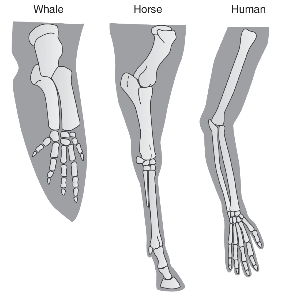
These are examples of which types of structures?
(A) analogous
(B) convergent
(C) homologous
(D) vestigial
5. Triclosan is an antibacterial chemical that is used in some household products to reduce bacteria levels. Which of the following is the most likely result of increased use of products that contain triclosan over time?
(A) All household bacteria species will be eliminated.
(B) Household bacteria species will become resistant to triclosan.
(C) Individual bacteria will learn how to resist the effects of triclosan.
(D) Increased triclosan levels will increase the frequency of mutations in household bacteria.
6. Snakes feed on toads. Cane toads (Rhinella marina) excrete a toxic substance on their skin that is poisonous to many, but not all, snake species. If cane toads are introduced to a new environment, predict the most likely effect on the snake species in that environment.
(A) All snake species in the environment will die out due to the cane toads’ toxin.
(B) Snake species that are resistant to the cane toads’ toxin will increase in numbers.
(C) Snakes that are susceptible to the cane toads’ toxin will acquire resistance to the toxin.
(D) All snake species will learn to avoid eating cane toads.
7. The human TAS2R38 gene encodes a cell membrane protein that influences the ability to taste bitter compounds. Individuals who possess at least one TAS2R38 allele have the “taster” phenotype and can taste certain types of bitter compounds. It is estimated that about 70% of humans have the taster phenotype. Which of the following best explains the frequency of the taster phenotype?
(A) Many toxic compounds have a bitter taste, so the TAS2R38 allele provided a survival advantage in ancestral humans.
(B) Ancestral humans with the TAS2R38 allele were more likely to consume bitter-tasting foods.
(C) Bitter-tasting foods have a higher nutrient content and were more likely to be consumed by ancestral humans who did not have the TAS2R38 allele.
(D) A lack of the TAS2R38 allele provided a survival advantage in ancestral humans.
8. The Aztecs were some of the first humans to slowly change teosinte, also known as wild corn, into the current form of corn eaten today. Which process did the Aztecs most likely use?
(A) artificial selection
(B) frequency-dependent selection
(C) natural selection
(D) sexual selection
9. Which of the following assertions (about how evolution by natural selection occurs) is incorrect?
(A) There are variations among individuals of a species.
(B) Some variations provide a survival advantage.
(C) Variations acquired during an individual’s lifetime are passed on to the individual’s offspring.
(D) Over time, the frequency of individuals with variations that provide a survival advantage will increase.
10. Rock pocket mice (Chaetodipus intermedius) are found in rocky outcrops in the desert of the southwestern United States. Some rock pocket mice have light-colored fur, while others have dark-colored fur. A population of rock pocket mice lives in a desert with both light-colored sand dunes and dark-colored rocks. Owls and hawks prey on the rock pocket mice they see. The initial ratio of light-colored to dark-colored mice in this population is approximately 1:1. A sandstorm occurs in the habitat of this population of rock pocket mice, and it covers all of the habitat in a thick layer of light-colored sand. Predict the most likely effect of this on the rock pocket mouse population.
(A) The relative frequency of dark-colored rock pocket mice would increase.
(B) The relative frequency of light-colored rock pocket mice would increase.
(C) The numbers of both dark-colored and light-colored rock pocket mice would decrease.
(D) The numbers of both dark-colored and light-colored rock pocket mice would increase.
Short Free-Response
11. Three new species (A, B, and C) of fossilized crocodile are discovered. The characteristics of these species are compared to those of the saltwater crocodile, Crocodylus porosus. The saltwater crocodile is found in Southeast Asia and Australia, and adults range in length from 5.5 to 5.8 meters and have 66 teeth. Data comparing the characteristics of the three fossilized crocodile species are shown in the table.
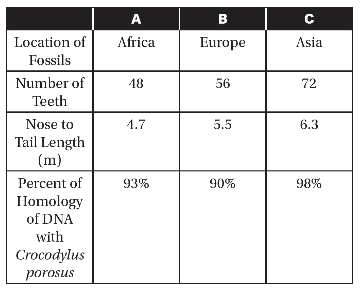
(a) Based on the data given, identify the fossil species that has the most in common with Crocodylus porosus.
(b) The number of teeth in a crocodile jaw correlates with increased predator efficiency. Identify the crocodile(s) that would be less efficient predators than C. porosus.
(c) Evaluate the claim that species B shares a more recent common ancestor with C. porosus than do species A or species C.
(d) Explain your reasoning for your response from part (c).
12. A student performs an experiment to study the effects of repeated exposure to antibiotics on bacteria. A strain of E. coli that is not antibiotic resistant is grown on an antibiotic-free LB agar plate (plate 1), the starter plate. Some of the E. coli from the starter plate are then spread on a plate that contains LB agar and 50 ug/mL of the antibiotic ampicillin (plate 2), and some of the E. coli are spread on a plate that contains LB agar without antibiotic (plate 3). E. coli from plate 2 are then spread on a plate that contains LB agar and 100 ug/mL of the antibiotic ampicillin (plate 4). E. coli from plate 3 are then spread on a plate that contains LB agar without antibiotic (plate 5). A diagram of the experimental plates is shown in the figure.
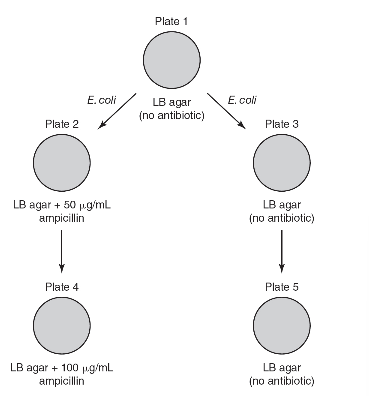
(a) Describe whether E. coli that are all susceptible to ampicillin, all resistant to ampicillin, or a mix of both will grow on the starter plate. Explain your answer using the principles of natural selection.
(b) Identify the plates that serve as controls in this experiment. Identify the independent variable in the experiment.
(c) Predict the relative amount of E. coli growth on plates 2, 3, 4, and 5.
(d) Justify your prediction from part (c).
Long Free-Response
13. Wild guppies (Poecilia reticulata) live in ponds on the island of Trinidad. Male guppies have great variation in the number and colors of spots, leading to a wide variety of color patterns among male guppies. Female guppies do not express these spots and are drably colored. Female guppies will more often choose to mate with males who possess bright color patterns. However, males with brighter color patterns are more visible to predators. An experiment was performed to measure the effect of the presence of a guppy predator (Cichlidae alta) on the number of spots in male guppies. Guppies were placed into two different environments: one with no predators and the other in which C. alta was present. Guppies were allowed to reproduce in both environments for 20 generations. After 20 generations, the number of spots on each male guppy was counted. The mean number of spots on male guppies is shown in the table.

(a) Describe the type of selection (directional, stabilizing, or disruptive) that is caused by the presence of C. alta.
(b) On the axes provided, construct a graph of the mean number of spots per male guppy for each group. Include 95% confidence intervals on your graph.

(c) Use the graph you constructed in part (b) to make a claim about the mean number of spots per male guppy in the no-predator environment as compared to the mean number of spots per male guppy in the environment with C. alta. Support your claim with evidence from the graph.
(d) As a follow-up experiment, some of the guppies in the environment with C. alta were removed and placed in an environment with no predators. They were allowed to reproduce for 20 generations. Predict what you would expect to happen to the mean number of spots per male guppy in this new predator-free environment after the guppies were allowed to reproduce for 20 generations. Justify your prediction.
Practice Questions
Multiple-Choice
1. In which populations is genetic drift more likely to occur?
(A) large populations
(B) small populations
(C) populations with great diversity
(D) populations with a high degree of gene flow
2. A group of birds is flying south during their yearly migration when a hurricane with extremely strong winds occurs. Only 10% of the group survive the storm, reaching their winter nesting site and reproducing the next spring. This type of event is an example of
(A) the bottleneck effect because only the fittest members of the population survived.
(B) the bottleneck effect because the population size was rapidly reduced.
(C) the founder effect because the group of birds from before the storm were not genetically diverse.
(D) the founder effect because the birds colonized a new habitat and never migrated again back to their original habitat.
3. Which of the following best explains the conditions under which the founder effect occurs?
(A) Random evolutionary change happens over multiple generations, causing a large population to separate into two smaller, genetically different populations.
(B) A population’s size is rapidly reduced, and the genetic diversity of the surviving population is not representative of the original, larger population.
(C) A small group of individuals from a larger population colonizes a new habitat. The small group that colonizes the new habitat does not possess the genetic diversity of the original, larger population.
(D)Environmental pressures select for the individuals with the adaptations that give them a greater likelihood of surviving and reproducing.
4. An isolated population in the United States are descendants of approximately 200 immigrants who arrived in the 1700s. Some individuals in this group of immigrants carried the allele for Ellis-Van Creveld syndrome. Today, this allele occurs at a much higher frequency in the descendants of this group than in the general population in the United States. This difference in the frequency of the Ellis-Van Creveld allele is an example of
(A) the bottleneck effect.
(B) the founder effect.
(C) natural selection.
(D) random mutations over multiple generations.
5. A scientist is studying the allele frequencies for a particular gene in a population of wild prairie dogs over a five-year period. The allele frequencies are shown in the table.
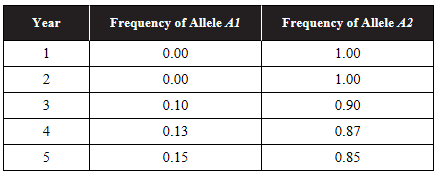
Which of the following is the most likely cause of the observed change in allele frequencies?
(A) artificial selection
(B) natural selection
(C) genetic drift
(D) gene flow
6. The following table shows the frequency of three genotypes (AA, Aa, and aa) in a population.

The environment of the population changes so that individuals with the Aa genotype are more likely to survive and reproduce. Predict what would most likely happen to the frequencies of the AA and aa genotypes after 10 generations in this environment.
(A) The frequencies of both the AA and aa genotypes would increase.
(B) The frequencies of both the AA and aa genotypes would decrease.
(C) The frequency of the AA genotype would increase, and the frequency of the aa genotype would decrease.
(D) The frequency of the AA genotype would increase, and the frequency of the aa genotype would be 0.
7. Which of the following is a characteristic of a population that is in Hardy-Weinberg equilibrium?
(A) small population size
(B) gene flow
(C) sexual selection
(D) no mutations
8. Ebony body color is an autosomal recessive trait in fruit flies. In a large, randomly mating population of fruit flies that is in Hardy-Weinberg equilibrium, the frequency of ebony body color is 21%. What is the percentage of the population with the homozygous dominant genotype?
(A) 29%
(B) 45%
(C) 54%
(D) 79%
Questions 9 and 10
For a genetic disease that appears in homozygous recessive (aa) individuals, individuals who are heterozygous (Aa) for the disease are resistant to infections by certain parasites.
9. If 19% of the individuals in a population have the genetic disease, what is the frequency of individuals who are resistant to the parasites? Assume the population is in Hardy-Weinberg equilibrium.
(A) 0.436
(B) 0.492
(C) 0.564
(D) 0.810
10. Over half of the individuals living in a population where a particular parasite is prevalent are heterozygous for a recessive allele (Aa). Further studies reveal that individuals who are heterozygous for the recessive allele are resistant to the parasite, while individuals who are homozygous dominant or homozygous recessive are susceptible to the parasite. If the parasite was totally eliminated from this area, predict what would happen to the frequencies of the AA, Aa, and aa genotypes.
(A) The frequencies of the AA and aa genotypes would increase, and the frequency of the Aa genotype would decrease.
(B) The frequency of the AA genotype would decrease, and the frequencies of the Aa and aa genotypes would increase.
(C) The frequency of the Aa genotype would increase, and the frequencies of the AA and aa genotypes would decrease.
(D) The frequency of the aa would increase, and the frequencies of the AA and Aa genotypes would decrease.
Short Free-Response
11. A scientist is studying the allele frequencies in a population over several generations to help determine if the population is undergoing evolution. The data are shown in the table.

(a) Describe why looking at allele frequencies over several generations could be used to determine if a population is undergoing evolution.
(b) Describe the changes in alleles A1 and A2 from generation 1 to generation 4.
(c) Evaluate the scientist’s hypothesis that this population is undergoing evolution based on the data available.
(d) Explain how the data would differ if individuals with the genotype A1A2 were more likely to survive than individuals with the genotype A1A1 or individuals with the genotype A2A2.
12. Wildfires in the western United States have drastically reduced the size of some animal populations and destroyed the habitats of other animal populations.
(a) Describe how wildfires can create the bottleneck effect in a population.
(b) 90% of the habitat of a spotted owl colony was destroyed by a wildfire. A small percentage of the surviving owl population migrated to a new habitat. Explain the type of genetic drift this illustrates.
(c) The banana slug, Ariolimax columbianus, lives in the redwood forest in the mountains near Santa Cruz, California. A wildfire in these mountains in the summer of 2019 divided the slug’s habitat with a large area of dry ash that the slugs cannot cross. Predict the effect this had on the genetic diversity of the banana slug population.
(d) Justify your prediction from part (c).
Long Free-Response
13. The California kangaroo rat, Dipodomys ingens, is considered an ecosystem engineer for its role in creating extensive burrowing systems that can change soil characteristics and provide habitats for other species. Fur color in D. ingens ranges from white to sandy to brown. Ecologists counted the number of D. ingens in an area before and five years after a large mudslide killed the majority of the kangaroo rats in the area. Data are shown in the table.
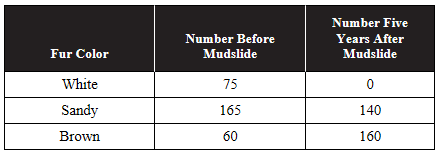
(a) Describe the probable cause of the change in frequency of fur color phenotypes in D. ingens after the mudslide event.
(b) Identify an appropriate control group for this study.
(c) Analyze the data with regard to how the mudslide affected the frequencies of fur color phenotypes in D. ingens.
(d) The burrows created by D. ingens provide habitats for many lizard species. In order to prevent future mudslides, retaining walls were constructed on the hillsides in the area, and the number of D. ingens in the area decreased by over 85%. Predict the effect of this on the lizard species diversity in the area, and justify your prediction.
Practice Questions
Multiple-Choice
1. In the 1950s, Stanley Miller performed an experiment to investigate the possible origin of the molecules required for life on Earth. Water vapor, methane, hydrogen gas, and ammonia were placed in a flask, and electric charges were applied to the system to simulate atmospheric conditions that were thought to be prevalent at the time. After many weeks, amino acids were produced in the system. Which of the following hypotheses is best supported by the results of this experiment?
(A) The molecules needed for life on Earth were brought to Earth by a meteorite.
(B) The molecules needed for life could have formed from inorganic compounds in Earth’s early atmosphere.
(C) The first molecules needed for life (that were formed in Earth’s early atmosphere) were RNA.
(D) The first molecules needed for life (that were formed in Earth’s early atmosphere) were carbohydrates.
2. Which of the following pieces of evidence best supports the hypothesis that birds are more closely related to reptiles than to other animals?
(A) Fossils of birds and reptiles are first seen in rock layers from the same time period.
(B) Birds and reptiles live in similar habitats and occupy the same trophic levels.
(C) Both birds and reptiles are the only animals with amniotic eggs.
(D) Molecular studies show that the DNA from birds has a greater degree of homology with the DNA from reptiles than with the DNA from other animals.
3. Generally, which type of data is considered most reliable when constructing phylogenies?
(A) fossil evidence, because it shows when species originated
(B) biogeography, because it shows organisms’ habitats
(C) morphological characteristics, because they show body structures
(D) molecular evidence, because it is less prone to convergent evolution or changes caused by geological events
Questions 4 and 5
Five new bacterial species were discovered in the Mariana Trench in the Pacific Ocean. The glyceraldehyde 3-phosphate dehydrogenase (GAPDH) gene was sequenced in all five species, and the number of nucleotide differences in the GAPDH gene among the five species is shown in the table.
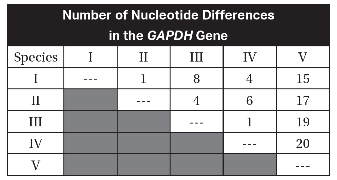
4. Which of the following cladograms is best supported by the data in the table?
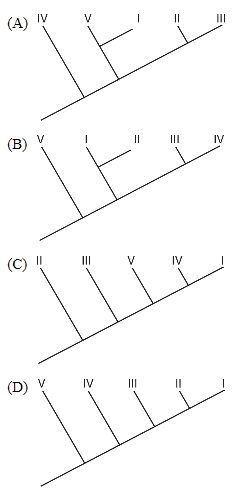
5. Based on the data in the table, which species is the outgroup?
(A) II
(B) III
(C) IV
(D) V
6. Which of the following best supports the existence of a common ancestor of all three domains of living organisms (Archaea, Bacteria, and Eukarya)?
(A) All living organisms perform glycolysis in their cytoplasm.
(B) All living organisms have membrane-bound organelles.
(C) All living organisms have linear chromosomes.
(D) All living organisms have genes that contain introns.
7. Some species of birds have unique bird songs that only attract members of the same species. This is an example of which type of reproductive isolation?
(A) behavioral
(B) gametic
(C) habitat
(D) mechanical
8. Orchids that belong to the genus Dendrobium will flower in response to certain weather stimuli. One species of Dendrobium flowers on the 8th day and closes on the 9th day after the weather stimuli, while another species of Dendrobium flowers on the 10th day and closes on the 11th day after the weather stimuli. This is an example of which type of reproductive isolation?
(A) habitat
(B) mechanical
(C) temporal
(D) hybrid breakdown
9. Which of the following is an example of mechanical reproductive isolation?
(A) The sea urchin species Strongylocentrotus purpuratus and Strongylocentrotus franciscanus both live in the same marine habitat and release their gametes simultaneously into the surrounding water. However, the gametes cannot form a zygote.
(B) In some snail species, the direction of the coil of the shell is controlled by a single gene. Snails with left-coiling shells cannot mate with snails with right-coiling shells because their copulating organs do not align.
(C) The fruit fly species Drosophila persimilis breeds in the early morning, and the fruit fly species Drosophila pseudoobscura breeds in the late afternoon.
(D) The bullfrog species Rana draytonii and Rana catesbeiana can mate and produce a zygote, but the zygote is not viable.
10. Tigers (Panthera tigris) and leopards (Panthera pardus) can mate and produce a zygote. The zygote will undergo cell division a few times, but this fails to result in the production of a viable embryo. This is an example of which type of reproductive isolation?
(A) gametic
(B) reduced hybrid viability
(C) reduced hybrid fertility
(D) hybrid breakdown
Short Free-Response
11. The following figure is a cladogram that represents the suspected ancestry of five species.
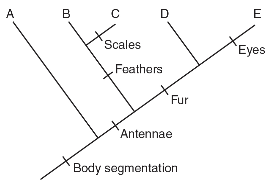
(a) Describe the characteristic(s) of the species that is the outgroup on this cladogram.
(b) Describe the similarities and differences in the characteristics present in species B and species D.
(c) A new species (X) is discovered, which has body segmentation, antennae, and fur but does not have eyes or scales. Construct a line that represents the ancestry of species X on the cladogram.
(d) Explain why species C is placed off of the same branch as species B and not the same branch as species D.
12. Two species of ground squirrels are separated by a river that they cannot cross. Genetic analyses of the two species of ground squirrels indicate that 99.3% of their DNA is homologous.
(a) Describe the type of reproductive isolation that separates the two species of ground squirrels.
(b) Explain how homology in DNA is used to determine ancestry.
(c) Due to a severe drought, the decision is made to divert water away from the river to a reservoir that supplies water for a nearby city, and the river separating the two species dries up. Predict the effect this will have on the two species of ground squirrels in the area.
(d) Justify your prediction from part (c).
Long Free-Response
13. The males of a particular species of bird attract mates with their bird songs. Male birds were observed, and the duration of their bird songs were recorded. The durations of the bird songs were classified into three groups: less than 120 seconds, 120–299 seconds, and 300–480 seconds. The number of females that approached the male birds within the 30-minute period, including during and immediately following the bird songs, was recorded. A graph of the data with 95% confidence intervals follows.

(a) Based on the data provided, make a claim about how the duration of the bird songs affects the number of females approaching the males.
(b) Describe the type of reproductive isolation that bird songs are an example of. Identify one more example of this type of reproductive isolation.
(c) Analyze the data in the graph, and determine whether there is a statistically significant difference in the number of females approaching males with bird songs in the 120–299 second range and the number of females approaching males with bird songs in the 300–480 second range.
(d) Predict the number of females that would approach a male with a bird song that is longer than eight minutes (480 seconds). Justify your prediction.
Practice Questions
Multiple-Choice
Questions 1 and 2
Refer to the following food web.
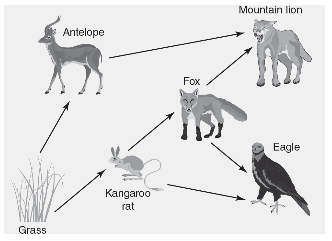
1. What is a role of the fox in this food web?
(A) producer
(B) primary consumer
(C) secondary consumer
(D) tertiary consumer
2. The application of rat poison in the area results in the elimination of the kangaroo rat population. Which of the following is the most likely effect of this event?
(A) The biomass of the producers will increase.
(B) The number of foxes in the ecosystem will likely increase.
(C) The amount of food available to the antelope will decrease.
(D) The mountain lions will eat fewer antelopes and more eagles.
(A) 90% of the nutrients are lost in each transfer to the next trophic level.
(B) 90% of the energy is lost in each transfer to the next trophic level.
(C) Decomposers can efficiently recycle nutrients for up to four trophic levels.
(D) The biomass at the producer level cannot exceed the biomass at the primary consumer level.
4. Coyotes are a predator of skunks. Coyote urine has a strong scent and is marketed as a skunk repellent. Which type of signal is coyote urine?
(A) audible
(B) chemical
(C) tactile
(D) visual
5. Which of the following is an example of a physiological response to a stimulus?
(A) A female bird moves toward a male bird that is singing an appropriate mating song.
(B) A predator avoids a brightly colored frog in the rain forest.
(C) A bear slows its metabolism in response to shortened day lengths and cooler temperatures.
(D) A primate grooms its offspring.
6. Why are the metabolic rates of smaller organisms generally higher than those of larger organisms?
(A) Smaller organisms have shorter life spans and therefore must accomplish more activities in less time. This requires a faster metabolic rate.
(B) Smaller organisms have a higher surface area to volume ratio than larger organisms and lose more heat to the environment.
(C) Smaller organisms are more likely to be ectothermic than larger organisms and therefore need a higher metabolic rate to compensate for this.
(D) Smaller organisms consume less food per gram of body weight than larger organisms and therefore need a higher metabolic rate to compensate for this.
Questions 7 and 8
Refer to the following food web. The arrows show the direction of the flow of energy, and species are represented by roman numerals.
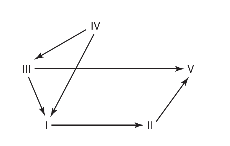
7. Which species in this food web is most likely a producer?
(A) I
(B) II
(C) III
(D) IV
8. Which species is both a primary consumer and a secondary consumer?
(A) I
(B) II
(C) III
(D) IV
The respiration rate (as measured by oxygen consumption per gram of body weight per minute) was measured in rats, grasshoppers, and newly discovered species animal X. The respiration rates were measured at 5°C and 30°C for all three species. Data are shown in the table.
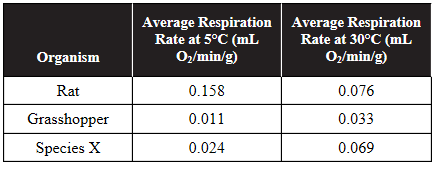
9. Which of the following conclusions about species X is best supported by the data?
(A) Species X is ectothermic since its respiration rate is higher at a higher environmental temperature.
(B) Species X is ectothermic since ectothermic animals always have an increased respiration rate at lower temperatures.
(C) Species X is endothermic since its respiration rate at 30°C is closer to the respiration rate of the rat at 30°C than to the respiration rate of the grasshopper at 30°C.
(D) Species X is endothermic since its respiration rate is higher at a higher environmental temperature.
10. This experiment is repeated with the same animals at a temperature of 37°C. Which of the following is the most likely result?
(A) The rat will have a higher respiration rate than the grasshopper at 37°C because rats are ectothermic.
(B) The grasshopper will have a higher respiration rate than species X at 37°C because grasshoppers are ectothermic and species X is endothermic.
(C) Species X will have a higher respiration rate than the rat at 37°C because rats are ectothermic and species X is endothermic.
(D) The rat will have a lower respiration rate than both the grasshopper and species X at 37°C because rats are endothermic and both grasshoppers and species X are ectothermic.
Short Free-Response
11. The following table shows the diet composition of members of an estuarine ecosystem (a shallow, coastal shelf where a freshwater river empties into a larger saltwater body). Higher percentages indicate a higher degree of reliance on a particular food source. An “X” indicates that the source is not a food source for that organism.
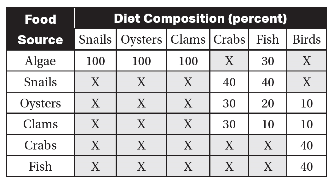
(a) Describe the role of algae in this ecosystem.
(b) Represent the relationships between these organisms by constructing a food web for this ecosystem.
(c) Identify the secondary consumers in this ecosystem.
(d) Predict the organism in this ecosystem that will have the lowest biomass. Explain why you made this prediction.
12. In order to investigate the possible effects that chemicals in a certain insecticide have on plant growth, a researcher grew 100 plants from each of three different crop species. Fifty plants of each type were grown in a lab in the presence of the insecticide, and the other 50 plants of each type were grown in a lab without insecticide. All plants were grown to maturity and then dried, and the mean dry weight per plant and the standard error of the mean were calculated for each group. Data are shown in the table.
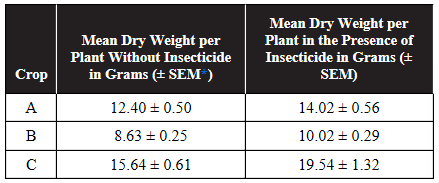
*Standard Error of the Mean
(a) Describe the effect of the use of the insecticide on the mean dry weight of crop B.
(b) Calculate which crop (A, B, or C) had the greatest percent increase in mean dry weight in the presence of the insecticide. Show your work.
(c) The researcher makes the claim that use of this insecticide increases the mean dry weight of all three crops. Using the data from the table, evaluate the researcher’s claim.
(d) Explain why the use of an insecticide could increase the yield of some agricultural crops.
Long Free-Response
13. Plants thought to have evolved in temperate climates use C3 photosynthesis (also known as the light-independent cycle). Plants thought to have evolved in tropical climates use an additional step referred to as C4 photosynthesis. Scientists measured the photosynthetic rate of C3 plants (sugar beets) and C4 plants (sugarcane) in a sealed container under three different temperature conditions. Data are shown in the table.
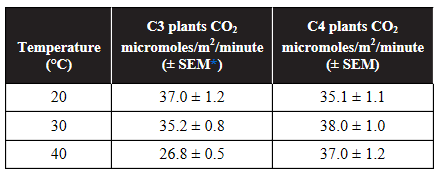
*Standard Error of the Mean
(a) Explain why the rate of carbon dioxide consumption was used in this experiment.
(b) Construct a graph of the data, showing 95% confidence intervals.

(c) Analyze the data, and determine at which temperature(s) there was a statistically significant difference in carbon dioxide consumption in C3 and C4 plants.
(d) Coleus is a popular C3 houseplant. A person has a Coleus plant inside her climate-controlled home, in which the temperature never exceeds 30° Celsius. If this plant was placed outside for seven days during a heat wave (in which the high temperature each day reached 39°C), predict the effect this would have on the plant. Justify your prediction.
Practice Questions
Multiple-Choice
Questions 1 and 2
Refer to the figure, which shows the population of wild rabbits on an island as time progresses.
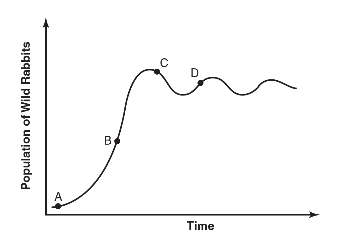
1. Which of the following best represents a time when the rabbit population was experiencing exponential growth?
(A) A
(B) B
(C) C
(D) D
2. Which of the following points best approximates the carrying capacity of the island for rabbits?
(A) A
(B) B
(C) C
(D) D
(A) 135
(B) 141
(C) 145
(D) 152
4. In 1986, the quail population in Golden Gate Park in San Francisco was 140 birds. Hunting by feral cats reduced the number of quail to 32 birds by 2016. If the birth rate of quail over this period averaged 20.4 quail/year, what was the average death rate of quail during this period?
(A) 2.4 quail/year
(B) 3.6 quail/year
(C) 24 quail/year
(D) 36 quail/year
5. A population of 190 jackrabbits lives in McInnis Park in San Rafael, California. The carrying capacity of the park for jackrabbits is approximately 200 rabbits. If the rmax for the jackrabbit population is 1.5 surviving jackrabbits per year, what is the estimated increase in the number of jackrabbits in one year?
(A) 10
(B) 14
(C) 285
(D) 300
6. Which of the following statements describes a population that could experience exponential growth?
(A) a population that was limited by density-dependent factors
(B) a population whose size is beyond the carrying capacity of the environment
(C) a population in which there are no limiting factors
(D) a K-selected population
7. Acacia ants (Pseudomyrmex ferruginea) live on acacia trees (Vachellia cornigera). The ants obtain food and shelter from the acacia trees, and the ants drive away animals that would otherwise eat the leaves of the acacia trees. Which of the following best describes the relationship between Pseudomyrmex ferruginea and Vachellia cornigera?
(A) niche partitioning
(B) commensalism
(C) mutualism
(D) parasitism
8. Two species of lynx spiders, Peucetia rubrolineata and Peucetia flava, both inhabit the plant Trichogoniopsis adenantha, a type of sunflower found in Brazil. However, Peucetia rubrolineata inhabit plants in shaded areas, while Peucetia flava inhabit plants in open areas. This is an example of
(A) competition.
(B) mutualism.
(C) niche partitioning.
(D) predator/prey relationship.
9. Cytisus scoparius, also known as Scotch broom, was introduced into California from England in the mid-1800s as an easy-to-grow plant that helped stabilize soil on the hillsides. One Scotch broom plant can produce over 12,000 seeds a year. Scotch broom forms a dense shade canopy that prevents seedlings of other plants from growing. There are no natural predators for Scotch broom in California since its leaves are toxic to most animal species. Which of the following most accurately describes Scotch broom’s role in the California ecosystem?
(A) keystone species
(B) invasive species
(C) mutualistic species
(D) native species
10. Tidal marshland A, which is adjacent to the San Francisco airport, has a Simpson’s Diversity Index of 0.65. Tidal marshland B, which is two miles from the airport, has a Simpson’s Diversity Index of 0.80. An oil spill occurs at a location at the halfway point between the two marshlands. If both marshlands are equally contaminated by the oil spill, which marshland is more likely to recover from the oil spill?
(A) Tidal marshland A is more likely to recover, because its lower Simpson’s Diversity Index means that few species will be affected.
(B) Tidal marshland B is more likely to recover, because its higher Simpson’s Diversity Index means it has a wider variety of species and can better absorb the effects of a disturbance.
(C) Both ecosystems will be equally affected, because they are the same distance from the oil spill.
(D) Neither ecosystem will be able to recover, because oil is toxic to all organisms.
Short Free-Response
11. A population of 45 geese are introduced to a lake. The birth rate of the population is 0.28 geese per year, and the death rate is 0.18 geese per year.
(a) Calculate the rate of population growth.
(b) Determine whether the population of geese is increasing or decreasing.
(c) The carrying capacity for geese at this lake is about 80 geese. Make a prediction about the population of geese relative to the lake’s carrying capacity for geese in the next 10 years.
(d) Justify your prediction from part (c).
12. On an island north of the Arctic Circle, the Arctic fox preys upon puffins, and puffins consume Arctic grass.
(a) Identify the trophic levels to which the Arctic fox, puffin, and Arctic grass belong.
(b) Explain why the number of Arctic foxes on this island will most likely be less than the number of puffins in a healthy ecosystem.
(c) Predict the effect that the elimination of all Arctic foxes on this island would have on the puffins and Arctic grass.
(d) Justify your prediction from part (c).
Long Free-Response
13. Largemouth bass (Micropterus salmoides) eat dace fish (Leuciscus leuciscus). Dace fish eat daphnia. Daphnia eat algae in the lake. The number of largemouth bass and dace fish in a lake are recorded over a 10-year period. At year 5, great blue herons (Ardea herodias) are introduced to the lake. Great blue herons feed on young largemouth bass. The following graph shows the data regarding the relative population sizes of the largemouth bass and dace fish over the 10-year period.
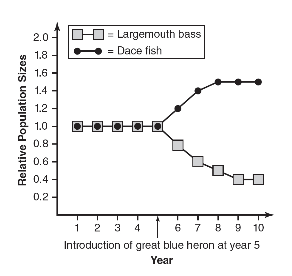
(a) Describe the trophic level of the dace fish in this ecosystem.
(b) Identify the independent variable and the dependent variable in this experiment.
(c) Analyze the data to determine the effect of the introduction of great blue herons on the population sizes of the largemouth bass and the dace fish.
(d) Predict the effect of the introduction of the great blue herons on the algae density in the lake. Justify your prediction.




